



You probably reached this "Blog2" page from that called
GPS Guided Trans-Atlantic Robot Boat,
or the
Design of Snoopy Sloop page
.
If not, click on a link to know more.
Each "blog" page describes detailed work preparing for the next Atlantic Attempt.
i.e. covering a period in the region of a year: less if more than one attempt is made.
The Blog pages were started after the first 2012 Attempt, where Snoopy's boat was lost. All later attempts were
with the same boat, sometimes after major repairs. The blogs provide online "Engineering Notebooks",
providing a day-by-day account of repairs, changes, and testing: mostly testing.
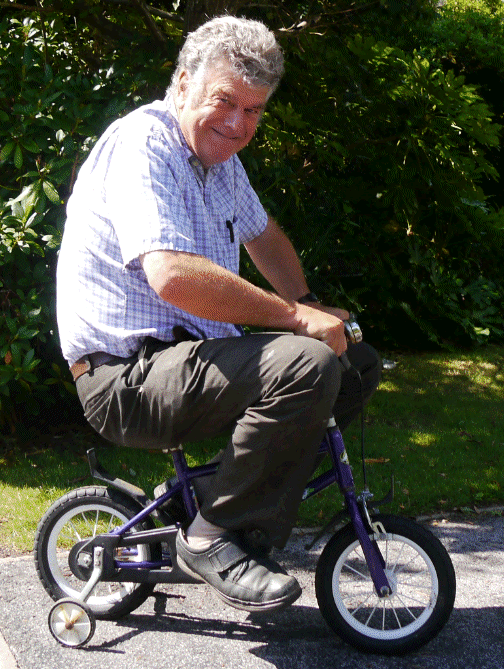
 These blog pages are mostly about numerous repairs to the boat, results from "BRAY LAKE TEsts", or 24/7 reliability testing on Bray Lake.
i.s. Snoopy sailing back and forth over a 24/7 waypoint in "Snoopy Corner". This is typically for several weeks,
in all weather, including gale force winds.
Sometimes, a few things happened which resulted in amusing pictures or stories,
such as countering human-intervention, or testing the wheels for Snoopy's trolly.
Click on the pictures either side for larger versions, or visit earlier blogs above.
BlogX, the "blog of experiments", shows ideas and products, some of which may appear
in future boats.
These blog pages are mostly about numerous repairs to the boat, results from "BRAY LAKE TEsts", or 24/7 reliability testing on Bray Lake.
i.s. Snoopy sailing back and forth over a 24/7 waypoint in "Snoopy Corner". This is typically for several weeks,
in all weather, including gale force winds.
Sometimes, a few things happened which resulted in amusing pictures or stories,
such as countering human-intervention, or testing the wheels for Snoopy's trolly.
Click on the pictures either side for larger versions, or visit earlier blogs above.
BlogX, the "blog of experiments", shows ideas and products, some of which may appear
in future boats.
This is a record of repairs and changes made to the boat, during recent weeks of testing on Bray Lake, after the Atlantic Attempt in October 2013. See Blog1 for earlier progress.
 In brief: Snoopy launched at 1215pm Friday 11th October 2013, wandered, landed about 3am Saturday, was rescued unharmed at 8am.
Now being prepared for his next attempt !
In brief: Snoopy launched at 1215pm Friday 11th October 2013, wandered, landed about 3am Saturday, was rescued unharmed at 8am.
Now being prepared for his next attempt !
Thursday 17th October 2013: this blog page will be updated with the details of tests, repairs, and design changes,
to give Snoopy a better chance of success on his next attempt, expected before Christmas. An important part of this
process will be repeated tests on Bray Lake, to try and uncover steering problems, including in strong wind.
Then testing of changes, such as adjustment of the sails and/or software steering logic. Then 24/7 testing to
give confidence in reliability.
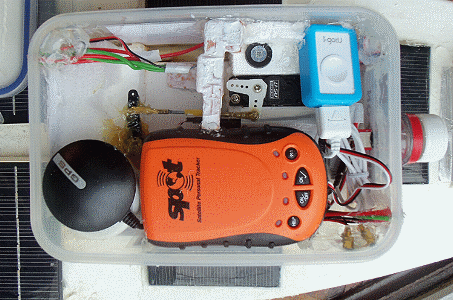
130pm update:
SPOT REPORTS STOP: yesterday Robin noticed the hourly automatic SPOT reports had stopped, so this is now an urgent item.
This SPOT subsystem has been running reliably 24/7 continuously for many months, since February this year.
It continued to work reliably during it's time on the muddy beach, and for several days, sat indoors at home.
The BBC changed the link "was launched" on their recent
news page this morning, from a direct link to the SPOT map, to a more appropriate page.
Robin also removed the prominent link from the "latest news". This was to see if the problem was overloading due to the number of visitors.
This was not a problem last year, despite much greater media attention.
The SPOT Messenger works OK if Robin presses the [OK] button to send a manual report.
e.g. that at 1808 yesterday. Interestingly, it did manage to send two automatic reports at 0018 and 0427 today.
The voltage at the monitor point was a good 3.66v. The next thing to check, after leaving the boat
untouched for longer, is to check wiring and the box containing the picaxe timer.
Some moisture was found inside the lunch box, when Snoopy returned home, but very little. It is possible that water forced it's way
past the lid and tape, in the first hours that the boat washed ashore at 3am. As the tide went out, before Dick arrived at 8am,
the same water may have drained back out via the same route. Robin remembers NOT having smeared silicon sealant around the lid,
before this attempt ! Dick's photo shows the boat laying on it's right side, and that is consistent with the rudder having been
pushed underneath, turning on it's rudder post. Also, the SPOT Messenger, the Autopilot picaxe, and perhaps the SPOT timer picaxe, might not have been as exposed
to water as the servo and wiring. These items need to be tested soon, even if OK for first Bray Lake tests.
The autopilot was switched on for a few minutes just now, and worked OK. At least one manual SPOT report will be sent each day.
Reliable SPOT tracking is the most essential requirement of all. If needed we can replace it's picaxe timer.
But that video also has relevance here, in the "engineering nitty gritty": the last two minutes show what Dick and I saw
when we first took the lid off the lunchbox: some moisture, but everything working OK - including the SPOT tracker.
I'll record some of my notes here, scribbled in my desk-diary. Work on the SPOT system has tended to be done slowly and carefully.
e.g. trying unplugging then plugging a (duplicated) connector, then waiting hours, to see if it starts transmitting again.
The most recent test was perhaps the most significant, and GOOD NEWS: if the SPOT messenger is unplugged, and the signal wire shorted to 0v,
it starts the transmission as it should. This seems to rule out corrosion inside the SPOT Messenger, at that VERY difficult spot
where we modified it. I've been trying things like pushing pins into the signal wire, to bridge or test what could be a corroded connector.
We will probably replace the duplicated futaba servo connectors with soldered joints, but first we need to find the fault.
This SPOT tracker has been working reliably every hour for months,
and days after his recent attempt and "crash landing".
My best guess is that small ammount of salt water has been slowly eating
at those duplicated connectors. If our recent change does not work, out with the soldering iron !
If that fixes it, then we can do a better job of rewiring - and I'll buy some shrink sleeves from Maplins ! :-)
Monday 21st October at 10am: SPOT PROBLEM FIXED. Replacement of Picaxe SPOT Timer did the trick: now regular hourly reports. Restarted at 10am
with adjusted software numbers, to fix loss of 6 secs per hour due to component tolerances on new board. Easily replaced,
and another two spares purchased for future spares at £10 each :-) Reports should now be every hour.
Friday 25th October updated at 1745: yesterday Snoopy had his first "Bray Lake Test" after his October Atlantic Attempt.
At first we thought our next test should be with a larger rudder, but then we saw from our video here that
he did a good, quick turn at his first waypoint. More importantly, he did seem to suffer from weather helm,
as we'd observed at the Atlantic Attempt.
Then I checked the sails again: the mainsail boom was nearer to 25 degrees than the usual 30.
Our next test will be with the mainsail let out more: to 40 degrees, to see what the effect is.
Thursday 31st October: The SPOT Tracking subsystem bits have been removed from the boat,
so they can be worked on, in parallel with Bray Lake tests of the boat. Work will include
putting the new picaxe timer into it's plastic box, after solding on duplicated servo leads.
Wiring will be replaced, with the probable change of duplicated connectors by soldered joints.
At least one manual SPOT transmission will be made each day, to keep the SPOT map "alive"
( after 24 hours it will show no data ).
The I-GotU has been put back inside the boat,
connected to the small solar panel, and switched on.
Maybe it had not been switched on, before the October Attempt ? :-)
Monday 4th November: Three Bray Lake Tests were done, in a wind from West-Nor-West of 5 to 10 mph.
Click on any of the three GPS plots below, to see the results of each test.
First thoughts (before looking at video): We should try letting the mainsail out even further: less zig-zag downwind ? Still progress "tacking" upwind ?
The big surprise was downwind - the unwanted zig-zag was as bad as before, when the mainsail was pulled in.
Saturday 9th November: the next Bray Lake Test, hoping to reduce "zig-zag", is with the jib pulled in
to 30 degrees - similar to the mainsail. This was the setting that seemed to give best results in the past.
We will need a day with similar winds of 10+ mph, to compare GPS plots with those above.
Tuesday 12th November: Jib was pulled in, but zig-zag remained, clearly visible by eye and on video.
Less noticable on the GPS plot (click on map to right to see details), probably because less speed,
due to less wind (8 mph ?) and therefore smaller deviations. Next test will be with larger jib.
Recent tests at Bray Lake have been plagued by distorted speech from the text-to-speech unit,
that speaks information from the computer to shore. This may have been due to resistance through a corroded
connector, inside the lunchbox, which is now replaced by soldered joints.
The larger jib is now fitted, set at 40, to see if it reduces the unwanted zig-zag sailing.
Friday 29th November: FLAT BATTERY AGAIN ! Details are seen if you click on the GPS plot on the right.
Snoopy used opportunity to test boat 9 in a good wind of 10-15mph from WNW,
but silly mistakes stopped a useful test: should have checked main 5v power before
the test: it was only 2.74v after returning home ! Later tests showed that autopilot,
including GPS, rudder servo and speech, continue to work below 4v, but fail near 3.5v.
Also, the larger jib had not been tied securely, until Snoopy returned (by accident) to Base.
For the record: Sails with larger jib boom at 15 (but significant sail twist) and mainsail at 40.
Previously, the servo-rudder link was moved back to 2nd instead of 3rd hole from end: 45 to 40 degs rudder throw ?
Had removed the rubber glove finger, covering the top of the rudder post, to tighten the allen screw.
Was amazed to see no moisture at all inside - despite all the sea adventures since the seal was fitted on 26th March above.
Friday 20th December: Click on the GPS plot to the right, to see the details.
The rudder linkage had been moved back, from 2nd to 3rd hole from end, to increase the rudder throw
from 27 to 32 degrees. Mainsail had been let out from 40 to nearer 60 degrees, and the Jib pulled in from 40 to 30 degrees.
Intention was to increase effect of rudder (again) and reduce "weather helm" (turning into the wind). Maybe we should
next try moving the mast forward, to alter the balance of the boat, and reduce "weather helm" ?
On the left is the 2012 boat 8, saying bye-bye to Bray Lake. I remember this earlier boat as not suffering from the "zig-zag" sailing problem.
Maybe the effective "centre of effort" of it's small keel, was moved back by the effect of the rudder ?
The blog above shows our trying most of the changes to sail settings, including a larger jib, without solving the problem.
I've gone back to the original, smaller jib, and we will see if this new mast position helps. Both sail booms are
set to about 30 degrees from centre.
Wednesday 8th January 2014: Test sail on Bray Lake, but wind dropped to zero, so nothing learnt, other than how good the
new Mobius deck camera is: more about that below.
The new 14 minute video is
here and part of a frame from the Mobius camera is below.
Tuesday 14th January: Minor repairs made to keel, with fastglass, Isopon P38 and P40, then painted.
Mast moved back to original position, with mainsail at 30 and jib at 40. Minor improvements
to FM antenna, to give more range. Total boat weighed and found to be 15.5 kg ! In February it was 12.3 kg,
and some of the increased weight will be due to water ingress into foam cavities. This will be looked at,
before 24/7 testing. e.g. remove unused dead batteries and any wet foam or water. For now we will assume
that the boat will weigh less than 15 kg when launched for the (first) Microtransat 2014 attempt.
The boat is ready for the next Bray Lake Test - to check the effect of adding the skeg.
From Mobius deck camera when Snoopy was heading directly towards Base ...
Wind was probably nearer to 5mph
than the forecast 10mph, so more tests are still needed. The FM reception was worse than it has ever been,
but the computer speech came out perfectly on the deck camera video.
Work will continue on fixing the zig-zag problem, but we will also look into how we log GPS data -
or perhaps pay more attention to our recorded videos than the finer detail of the GPS log !
On the right you see the boat after fitting the temporary push rod to connect autopilot drive shaft to the rudder.
The FM Transmitter with it's microphone and PP3 battery is now in it's own box at the very back, with an on/off switch.
This was after diagnosing that the distorted speech was probably due to it having been in the same box as
the text-to-speech loudspeaker, overloading the audio circuit. We hope we will then hear better, via our tranny radio,
what the computer is saying.
We expect the next test will be with the larger, balanced rudder, in it's original position.
On the left is the new balanced rudder fitted. I made it days ago, while waiting for wind !
We will see how the new rudder works, then decide what to do next. e.g. revert to the rear rudder
or remove the skeg. This new rudder, in the original position, means we do not need to re-engineer
the sandwich box(s).
Saturday 8th February: yesterday's sail was in a strong wind of 15mph+ from WSW, and the boat was unable to
reach it's first waypoint A, to the SW. However, the test did seem to show that the bigger rudder at the
very back, had more than enough turning effect.
Sunday 9th February: Maybe "Major Rebuild" is a better term than "Tidy-up" - even if it only takes a few days.
On the left is the boat on Sunday morning. We've already reduced the weight by removing 1.25kg of unused batteries,
buried in the hull, and 0.2L/kg of water from a gap between foam and f/g hull. That's reduced total weight
from 15.6kg to 14.15kg. i.e. nearly 10%. None of the old foam seemed to have soaked up water, so we used the same
squirty foam again: "HB Hilton Banks PU Hand Held Expanding Foam". A recently purchased "FIBOX TA201610T Enclosure"
is expected to replace the old "lunchbox", but mounted further back.
Sunday 23rd February: the 2nd and 3rd coats of Trilux paint were applied, and three solar lamp products
prepared for range testing, on poles with labels, should they be found. 1. "Bright"; 2 "Soft Glow"; 3 "Super Bright".
See left.
Sunday 2nd March: last night, not long after 6pm, we did our first range tests on the solar garden lights.
Monday 10th March: Over five hours of sailing tests, with the swing rig, in ideal conditions of a 10mph
breeze from the Nor-North-East, making it easy to get away and through waypoints A then B. Lots of video
yet to be analysed, but first impressions are that the swing rig may work OK if the jib is let out from
the boom by about 15 degrees. With the mainsail at 30, this gives similar angles as the usual sloop rig.
Pulling the jib right in seemed a disaster, and letting it out to 45 meant that it just flapped when
close to the wind - no surprises there ! We had three rescues, and after two of them, the rudder
had moved from centre - but we don't know when. The rudder "tightness" needs to be checked, and
we need to check with these best "swing rig 15+30" with recorded GPS track and Mobius video.
By the time we completed the first "swing rig 0+30" test, the Mobius and Pocket PC were
out of action, due to water getting at them: The boat was heeling over with these sail settings
and even this light breeze. It seems the boat could complete the test in close to 30 minutes,
with the best "swing rig 15+30" setting. We will test again soon, and confirm the above
after looking at our collected videos from Mobius, Camcorder, and Kodak camera.
Saturday 29th March: the strong wind of 15 to 20mph, gusting to 29mph, from the East-South-East
was too much to resist, so the boat was tested again, with everything almost identical to last Thursday's test.
i.e. the new sails both set at 30 degrees, but now laced, which was not expected to change their effect.
The FM transmitter, used to transmit computer speech to shore was not working, and this was found to be
a broken wire, fixed at home, ready for the next sail.
Wednesday 9th April: to aid those helping me with solving the "zig-zag sailing problem",
I've edited my video from yesterday down to 15 minutes,
which include the more interesting parts of the test, including that shot from cameras on the shore,
and on the deck.
I'm not yet sure what we will try next, when we
have another day with a strong wind: maybe try more rudder gearing ? Or maybe move the mast even further forward ?
Anyone have any ideas ? :-)
Thursday 10th April: I've moved the mast yet another 9cm/3.5" forward. This is 20cm/8" forward from it's original position,
and after discussion with others, and looking again at the video above.
Sunday 27th April: yesterday's sail was in a good 15mph+ wind from the south. Click on the GPS plot on the left
to see the details. The plot, and the videos, reveal a tendency to steer to the right of the target waypoint,
applying left rudder corrections. This was confirmed at home - the rudder was not exactly central! The servo
linkage has been adjusted, extended by two complete turns, equivalent to about 1.9 degrees - based on the "stick test".
This is all pointing to the fact that the autopilot is very sensitive to an error in rudder central position.
The good news is that an error can be seen during a Bray Lake Test. We are now waiting for strong wind again.
Wednesday 7th May: Robin and Dick took Snoopy out in a strong West-Sou-West wind of about 20 gusting to 30mph.
No GPS plot because the log file was lost when water got into the Mio Pocket PC and the program froze.
However, after a dry-out at home and a reboot, the Mio is working and ready for the next test. The strong wind
meant that progress upwind was very poor, and so we re-launched further along the bank, so Snoopy could
reach waypoint A, then Waypoint B after another re-launch. Then, returning from B, through C, D and back to Base,
with the wind behind him, this 320 metres was completed in 5.8 minutes - shown by the Mobius deck video camera.
This is an average speed of about 3.31kmh/2.06mph/1.79knots. Lack of a GPS plot, and particularly strong wind,
means no firm conclusions can be drawn, so we need to test again soon. Playing the Mobius video showed regular
"left" rudder corrections, regardless of what side the wind was from. Inspection indoors confirmed the rudder
was not exactly centred, so it was adjusted another two turns (left), ready for the next test.
Wednesday 14th May: Click on the GPS plot on the right to see details of todays two rapid laps around the lake:
both about 23 minutes and a record ! This confirmed the boat is in a good state, and can exploit kinder wind conditions,
such as today's 10mph from the North-East, meaning little tacking was needed.
Tuesday 27th May: Snoopy landed on south bank before 0608, despite wind of 6mph all night. Brought home after main 5v duplicated power
seen to be flat (2.73v,1.76v->2.5v). At home, disconnecting RHS battery showed fault in RHS solar panel (only 0.65v). So boat was running
on only 50% of it's solar power, and a day of no sunshine meant it went flat. The RHS solar panel was carefully removed to investigate then repair fault.
It seems to have been caused by leakage across corrosion. The four cells were checked, then resealed with strips of duck tape and
silicon sealant, used to glue the panel back in place. The two batteries were recharged (5.31v,5.31v->5.07v).
Extra "UK to USA" signs were fixed to either side of the box, and a lemonade
bottle top added to protect the ON/OFF switch. The boat was put back on 24/7 test at 3pm, and the SPOT map reset, so easier to see
how well Snoopy holds position in the coming hours.
So Snoopy must spend a few days at home while major repairs are made, before
he is put back on 24/7 test again.
Friday 30th May: Snoopy put back on 24/7 testing at 0905. SPOT map reset for clarity.
Thursday 5th June: kept near 24/7 waypoint, because wind more than 5mph all night. Sunny today - so good for solar charging of batteries :-)
Tuesday 10th June: Snoopy was put back on 24/7 test at about 10am. That's him sailing out on the right.
He got out to the 24/7 position within about 15 minutes,
despite having to tack directly into the 15 mph breeze from the south. The
Live SPOT Map.
has been reset, so we can see how well he keeps to his position. When the boat was checked this morning, before the trip
to Bray Lake, the rudder was "siezed solid". This was put down to foam having crept into the rudder shaft tube and set.
I should have remembered to re-grease the shaft before putting Loctite on the linkage.
The rudder was soon freed up, by turning it, and any friction is expected to reduce with continuous use.
Sunday 22nd June: I got some help from young engineers: click on the left picture for a better one. Snoopy has now been sailing
continuously for a week without failures. If the wind drops, he wanders, and needs to be pushed out again. This time
he started wandering at 930pm, hit a waypoint by accident, then completed "The Bray Lake Test", arriving at his Base
by 430am. When I got there, he was socialising with these young engineers and their parents. We measured battery voltages,
which were good and high (main 5v was 5.44,5.44->5.20v, and 3.6v SPOT was 3.85v). Everything was running well, so we let him
try the Bray Lake Test again - which he completed in less than an hour, in very light wind. Finally he was popped into Snoopy Corner,
to continue 24/7 reliability testing. Hot sun but very little wind.
Monday 25th August: 70 days (over 10 weeks) sailing without failure, on Bray Lake, waiting for the Atlantic launch window. Wanders when no wind.
Tuesday 2nd September: 77 days (11 weeks) continuous sailing without failure, on Bray Lake, waiting for the Atlantic launch window.
Maybe this coming weekend ?
Saturday 6th September 2014: Atlantic Attempt: details are on
September 2014 Attempt Page and this blog continues on the
Current Blog.
Repairs need to be made to the boat, for relaunch before the end of 2014.
That's Robin, sat on the bank of Snoopy Corner, watching Snoopy Sloop 10 on 24/7 test (right), filmed by experimental Boat 6.
Below is an early frame, from the Mobius video camera, now on boat 6. Here, Snoopy returns to Base, near the drain and Robin, Snoopy's chauffer :-)
Below is Snoopy being tested on a rather busy Bray Lake :-)
Visit counters, like revolvermaps below, are explained near end of the
Snoopy
page.
© 1991-2014 Robin Lovelock. Please credit www.gpss.co.uk if you use material from any of these pages. Thankyou.
 I-GOTU GPS LOGGER: This was set to record a GPS position every 12 minutes, and so it's data would be of great interest,
providing a more detailed track of Snoopy's path ( 5x more detailed than the hourly SPOT reports ), and also "fill the gap"
on Snoopy's movements near Christchurch, when we lost three SPOT reports - probably due to many SPOT users at that time.
The unit used was a replacement of that lost on Bray Lake in the "incident" reported earlier in this blog.
I-GOTU GPS LOGGER: This was set to record a GPS position every 12 minutes, and so it's data would be of great interest,
providing a more detailed track of Snoopy's path ( 5x more detailed than the hourly SPOT reports ), and also "fill the gap"
on Snoopy's movements near Christchurch, when we lost three SPOT reports - probably due to many SPOT users at that time.
The unit used was a replacement of that lost on Bray Lake in the "incident" reported earlier in this blog.
The bad news is that we got a "no data available" when trying to download the stored data using the supplied @TRIP software.
The good news is that a LOT of work was already in progress with this same I-GotU during the experimental work with boat6
in October, detailed on the
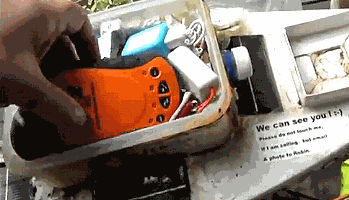 Sunday 20th October updated at 8pm: The most important work in the long term, is getting the SPOT tracker to work properly.
However, our priority this past week is getting information up onto pages such as October 2013 Atlantic Attempt
and the 10 minute utube video was only ready yesterday,
now on Video of Snoopy's October 2013 Atlantic Attempt.
We gave this work priority because it saves a lot of time in our direct discussions with many people,
including journalists who have stumbled upon the story, and many friends, some new, offering information, ideas, and advice.
Sunday 20th October updated at 8pm: The most important work in the long term, is getting the SPOT tracker to work properly.
However, our priority this past week is getting information up onto pages such as October 2013 Atlantic Attempt
and the 10 minute utube video was only ready yesterday,
now on Video of Snoopy's October 2013 Atlantic Attempt.
We gave this work priority because it saves a lot of time in our direct discussions with many people,
including journalists who have stumbled upon the story, and many friends, some new, offering information, ideas, and advice.
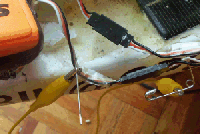 In the last few days, I've pressed the SPOT [OK] button at least once a day. e.g. on Friday 18th at 1800: Reported OK, and we
also got automatic reports at 1835, 1930, then 2119, 2226, and 0019 - then nothing after. On Saturday 19th the manual SPOT report
was at 2300 - and no automatic reports since then. Prior to that, other things were tried, including re-charging one of the
duplicated SPOT batteries, in case low voltage was effecting the picaxe timer: that had no effect. The picaxe timer box was
opened: no moisture, and all sealed by candle wax, so not thought to be likely cause of the recent problem.
In the last few days, I've pressed the SPOT [OK] button at least once a day. e.g. on Friday 18th at 1800: Reported OK, and we
also got automatic reports at 1835, 1930, then 2119, 2226, and 0019 - then nothing after. On Saturday 19th the manual SPOT report
was at 2300 - and no automatic reports since then. Prior to that, other things were tried, including re-charging one of the
duplicated SPOT batteries, in case low voltage was effecting the picaxe timer: that had no effect. The picaxe timer box was
opened: no moisture, and all sealed by candle wax, so not thought to be likely cause of the recent problem.
 The picture on the right has been used to update the
design page, since the documentation of the SPOT Picaxe Timer was not clear on what points
were used. Tests have also started with a spare picaxe timer, in case that is needed.
The new timer's first SPOT transmission was started at 1940 ( 7:40pm ), was received stamped 1955, and should repeat every hour.
The old picaxe timer will be tested independently.
The picture on the right has been used to update the
design page, since the documentation of the SPOT Picaxe Timer was not clear on what points
were used. Tests have also started with a spare picaxe timer, in case that is needed.
The new timer's first SPOT transmission was started at 1940 ( 7:40pm ), was received stamped 1955, and should repeat every hour.
The old picaxe timer will be tested independently.
Tuesday 22nd October: Adjustment of picaxe SPOT Timer continues. e.g. +0.5sec and restart at 1130.
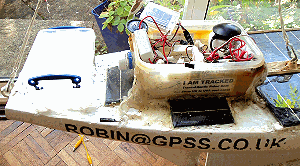 Wednesday 23rd October at 1545: SPOT Timer is now very accurate (0.1 sec / hour ?) and ready to be put into a sealed box.
Wednesday 23rd October at 1545: SPOT Timer is now very accurate (0.1 sec / hour ?) and ready to be put into a sealed box.
Boat weighed: NOW 14.5 kg ! This is nearly 2kg heavier than the 12.6kg declared on the Microtransat site,
probably based on what the boat weighed when it was completed early in 2013. Increased weight could be
combination of changes (above) and water having crept into cavities in the foam inside the hull (1.9kg = 1.9 litres of water).
Looking at the public videos, one might detect a very slight raising of the water-line, between February and June,
that includes months of 24/7 testing on Bray Lake. We do not expect this to change our practical work,
but our 2013 page on the Microtransat site could now say "14.5kg" :-)
On the right you see the new "really useful" box added for the Mio P350 GPS logger, and FM Transmitter / Text-To-Speech (TTS), for Bray Lake tests only.
i.e. the "Ship-to-Shore transmitter" function described on our
design page).
These tests on Bray Lake are expected very soon.
I found a problem with the TTS cable, from Autopilot inside the lunchbox, to the "Ship-to-Shore transmitter".
This is easily fixed, so we should have the TTS and FM transmitter added in the new box at the back soon.
This box can be removed or remain empty for the next Atlantic attempt.
It's main job is to hold the Mio P350 Pocket PC used to record accurate GPS plots.
Silver foil is glued to the front-facing part of the new box,
to reflect sunlight onto the I-GotU solar panel.
The chipped lettering on the hull was "repaired". i.e. marker pen followed by clear varnish.
 Work was interrupted by a long "Progress Meeting" at lunchtime, otherwise known as "Pub Grub with Friends". This went well: it was Stuart's turn to pay :-)
Work was interrupted by a long "Progress Meeting" at lunchtime, otherwise known as "Pub Grub with Friends". This went well: it was Stuart's turn to pay :-)
I've just added a new page, not yet public from elsewhere:
Questions and Answers - I'll be adding more to that soon.
Click on the picture on the right to see this GPS plot from Snoopy's first test,
after his October Atlantic Attempt. This confirmed the steering was terrible compared with last year's boat.
We soon expect to repeat the test but with a minor change, such as the sails adjusted. We will also look at the blog,
and our records back until early this year, to see earlier "Bray Lake Tests" and if a small repair change was done,
which might have effected the steering. We hope to do better than just change the weather window.
We want this boat to perform as well as earlier boats, in all directions relative to the wind.
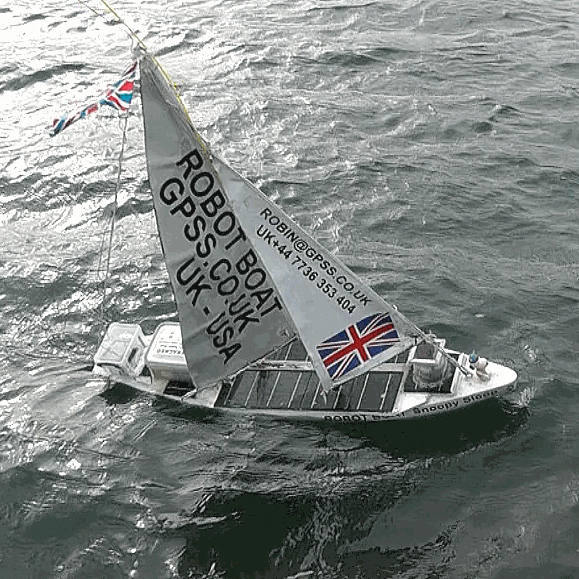 This test was started, but was aborted a few minutes after launch by Robin getting a 'phone call. The wind was very strong,
probably between 10 and 20 mph, and from the SSW. The new sail setting seemed to make Snoopy sail faster,
but he had great difficulty tacking away from the shore, to waypoint A which was almost directly upwind.
The mission was aborted, but it is expected Snoopy will have another try next week.
Click on the picture to the right, to see the big copy of it.
This test was started, but was aborted a few minutes after launch by Robin getting a 'phone call. The wind was very strong,
probably between 10 and 20 mph, and from the SSW. The new sail setting seemed to make Snoopy sail faster,
but he had great difficulty tacking away from the shore, to waypoint A which was almost directly upwind.
The mission was aborted, but it is expected Snoopy will have another try next week.
Click on the picture to the right, to see the big copy of it.
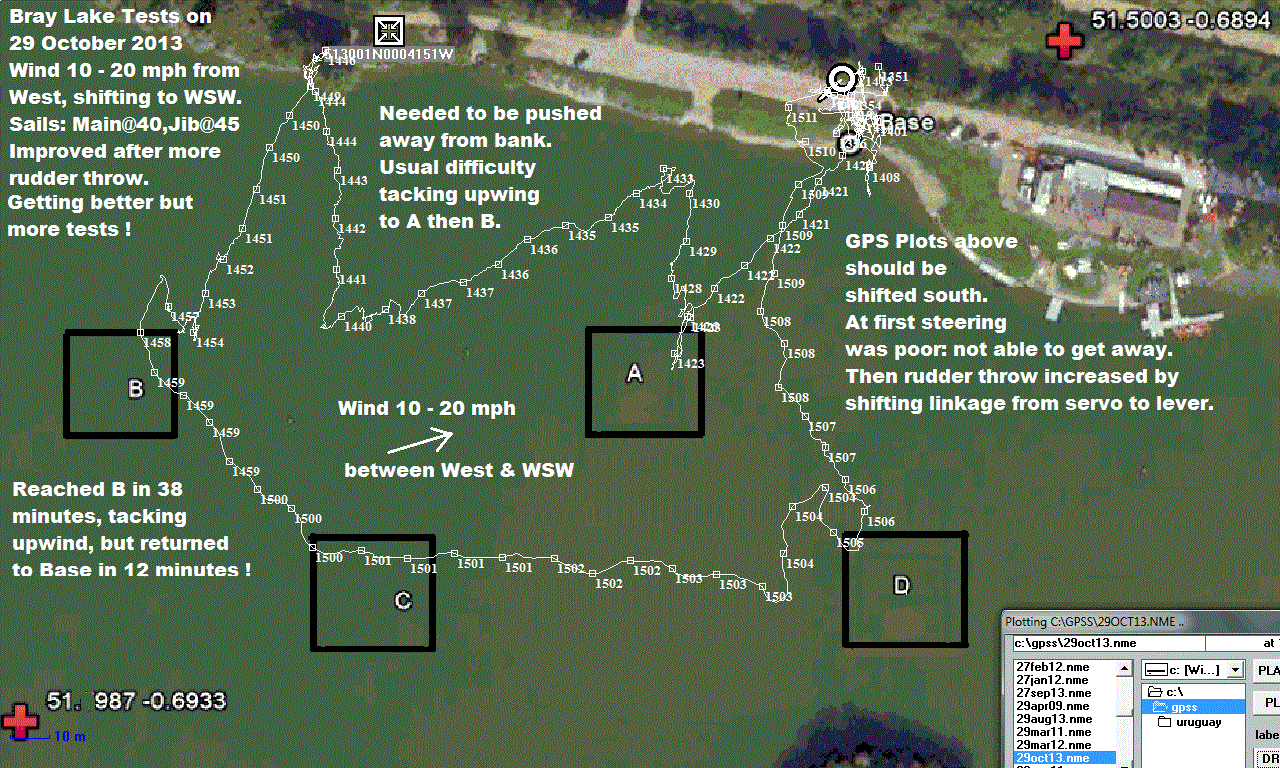 Tuesday 29th October 2013: Today's test indicates that our steering problem was probably simply due to not
enough rudder "throw". The blog above may show when we worked on the linkage between rudder servo and
the lever at the top of the rudder post. Perhaps we clipped it back into the wrong position !
Tuesday 29th October 2013: Today's test indicates that our steering problem was probably simply due to not
enough rudder "throw". The blog above may show when we worked on the linkage between rudder servo and
the lever at the top of the rudder post. Perhaps we clipped it back into the wrong position !
After first launch, the steering was still bad, and despite repeated attempts, the boat could not get away.
Then we simply moved
the servo-rudder linkage onto the next hole in the lever, closer to the rudder post. This gave the rudder more movement,
and the boat seemed to be "it's old self". This was with the sails still at their earlier experimental settings:
the jib at 45, but the mainsail let out from 25 to 40. Tests need to continue, adjusting rudder throw
(and/or maybe the size of the rudder) and sails, to get the best possible performance.
Click on the GPS plot on the left, to see the details.
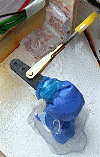 Wednesday 30th October: the blog above confirms that the servo linkage had been put back in the wrong place: probably
when it was changed on 8th July. See earlier, on 26th March, and this picture showing the linkage clipped into
the 3rd hole from the end of the lever. That's where we returned it yesterday ! So it HAD been moved (in July?)
to the 2nd hole, resulting in less rudder movement.
Wednesday 30th October: the blog above confirms that the servo linkage had been put back in the wrong place: probably
when it was changed on 8th July. See earlier, on 26th March, and this picture showing the linkage clipped into
the 3rd hole from the end of the lever. That's where we returned it yesterday ! So it HAD been moved (in July?)
to the 2nd hole, resulting in less rudder movement.
Yesterday, speech was unintelligable over the FM radio link, despite the boat being within range of our tranny radio
on the shore (we could hear water spashing, but the computer speech was distorted). There is now a bigger loudspeaker,
which may help the speech quality heard on the shore.
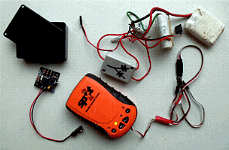 The next test will probably be with the same rudder and sail settings, to confirm we get similar results,
despite what will probably be a different wind direction and/or strength. We will continue these tests,
to find the optimum settings for the boat system, including boat and it's autopilot.
The next test will probably be with the same rudder and sail settings, to confirm we get similar results,
despite what will probably be a different wind direction and/or strength. We will continue these tests,
to find the optimum settings for the boat system, including boat and it's autopilot.

 The I-GotU needed to be tested. No further information had been received from Taiwan, and so
it was decided that the logged data probably could not be retrieved. The device was reset, using the @TRIP
software, and set to record GPS data at 1 point per second. This worked well enough, with a short walk
near home. The I-GotU was then set to the mode to be used for the Atlantic: One point every 12 minutes
and in "circular logging" and "power saving" mode. This worked OK when tested with a short drive between home and North Ascot.
It seems that the I-GotU is still working.
The I-GotU needed to be tested. No further information had been received from Taiwan, and so
it was decided that the logged data probably could not be retrieved. The device was reset, using the @TRIP
software, and set to record GPS data at 1 point per second. This worked well enough, with a short walk
near home. The I-GotU was then set to the mode to be used for the Atlantic: One point every 12 minutes
and in "circular logging" and "power saving" mode. This worked OK when tested with a short drive between home and North Ascot.
It seems that the I-GotU is still working.
 Friday 1st November: a slightly longer (by 5mm?) Z-link was installed, to correct rudder imbalance - it was turning
one way more than the other. The old picture on the left, from earlier in this blog, shows that the earlier Z-link
was slightly shorter than the servo linkage that it replaced.
Friday 1st November: a slightly longer (by 5mm?) Z-link was installed, to correct rudder imbalance - it was turning
one way more than the other. The old picture on the left, from earlier in this blog, shows that the earlier Z-link
was slightly shorter than the servo linkage that it replaced.
 Also, a removable plastic rudder extention, held by three bolts and wing-nuts,
was made for future experiments on the size of the rudder. Scissors can be used to make it smaller.
The boat is ready for Bray Lake Tests ! :-)
Meanwhile, the bits of the SPOT Tracker subsystem are being reassembled carefully. The duplicated servo leads,
between the SPOT Messenger and it's PICAXE Timer, were soldered onto the RHS servo position.
Also, a removable plastic rudder extention, held by three bolts and wing-nuts,
was made for future experiments on the size of the rudder. Scissors can be used to make it smaller.
The boat is ready for Bray Lake Tests ! :-)
Meanwhile, the bits of the SPOT Tracker subsystem are being reassembled carefully. The duplicated servo leads,
between the SPOT Messenger and it's PICAXE Timer, were soldered onto the RHS servo position.
 The lead
to the text-to-speech module, was simply plugged into the LHS position. This is only used for testing.
Several layers of water protection are provided, after that of Snoopy's Lunchbox: a plastic bag,
tied with knicker elastic, then the timer is put into the black plastic box, smeared with silicon sealant.
This time we did not use the candle wax, which makes testing of a failed unit difficult.
We may also put the SPOT Messenger in a plastic bag, even though it is supposed to be water-proof.
The lead
to the text-to-speech module, was simply plugged into the LHS position. This is only used for testing.
Several layers of water protection are provided, after that of Snoopy's Lunchbox: a plastic bag,
tied with knicker elastic, then the timer is put into the black plastic box, smeared with silicon sealant.
This time we did not use the candle wax, which makes testing of a failed unit difficult.
We may also put the SPOT Messenger in a plastic bag, even though it is supposed to be water-proof.
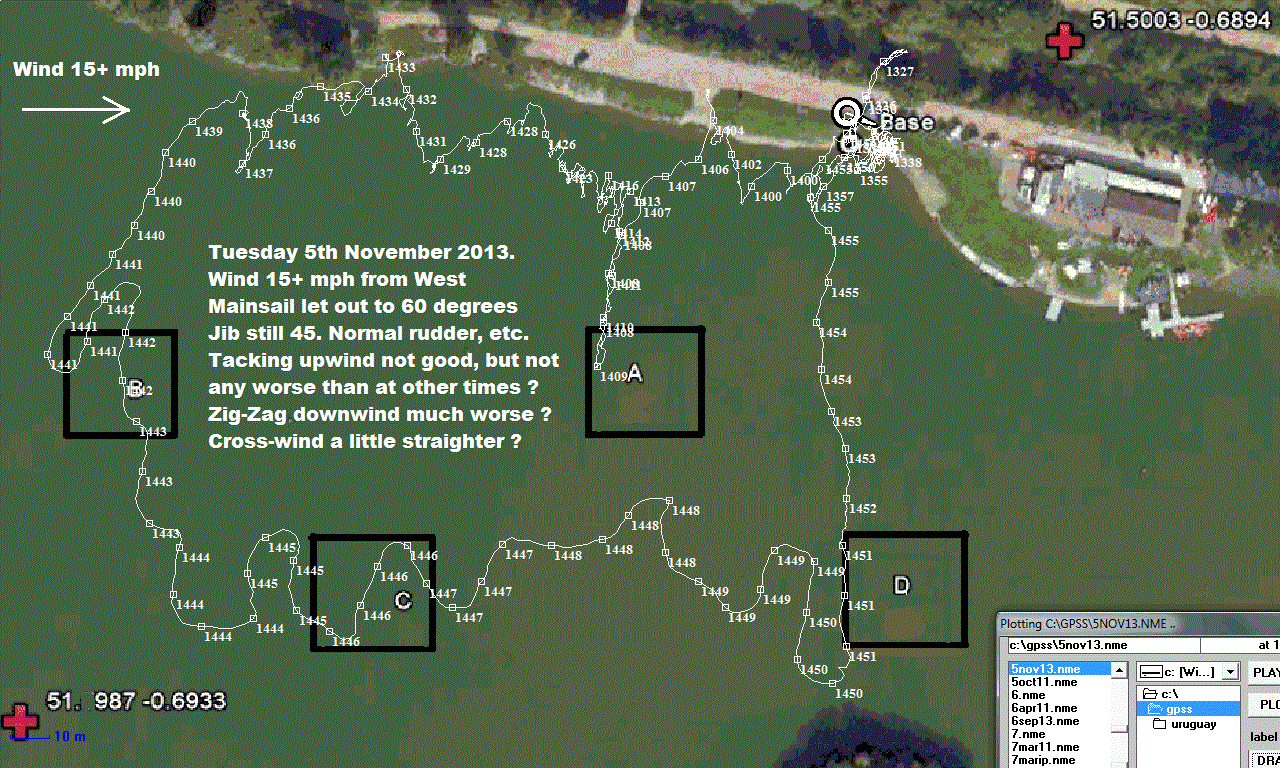 Tuesday 5th November: Click on the GPS Plot on the top-left, to see the details. Results were not what we expected
when we let the mainsail out to 60 degrees. We expected the upwind "tacking" to suffer, compared with when the
mainsail was pulled in to it's normal 30 degrees. However, considering how strong the wind was, at 15+ mph,
progress upwind was as slow as all other boats and sail settings. As is often the case, the boat had to be pushed
away from the north bank several times.
Tuesday 5th November: Click on the GPS Plot on the top-left, to see the details. Results were not what we expected
when we let the mainsail out to 60 degrees. We expected the upwind "tacking" to suffer, compared with when the
mainsail was pulled in to it's normal 30 degrees. However, considering how strong the wind was, at 15+ mph,
progress upwind was as slow as all other boats and sail settings. As is often the case, the boat had to be pushed
away from the north bank several times.
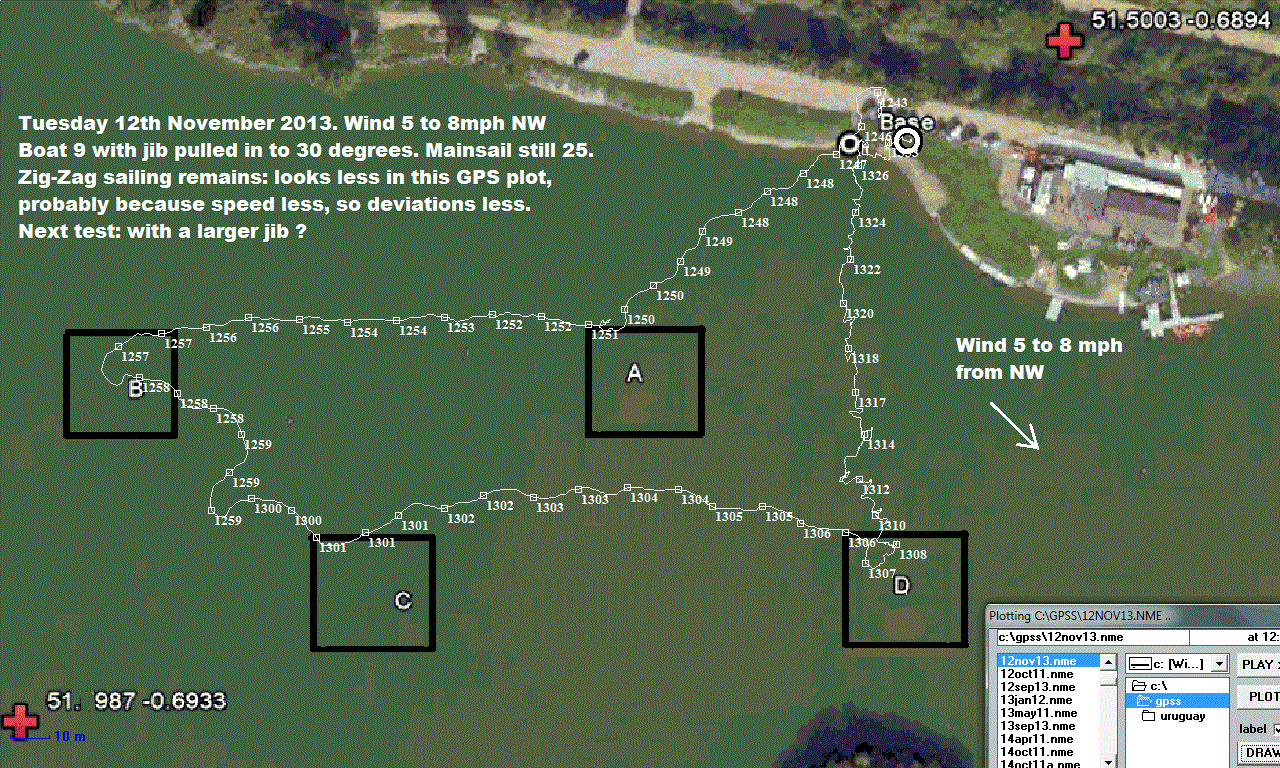
 The next test, after that, could be with a larger jib. Maybe it might act a little like a spinaker,
to "drag" the boat, and reduce zig-zag downwind. This picture on the right shows a larger IOM #2 jib,
behind the original IOM #3, for comparison. The SPOT Tracker parts were put back into Snoopy's lunchbox,
and soldered into the wiring, including solar panels.
The next test, after that, could be with a larger jib. Maybe it might act a little like a spinaker,
to "drag" the boat, and reduce zig-zag downwind. This picture on the right shows a larger IOM #2 jib,
behind the original IOM #3, for comparison. The SPOT Tracker parts were put back into Snoopy's lunchbox,
and soldered into the wiring, including solar panels.
 Wednesday 13th November: IGotU GPS Logger was tested, after many days recording data at 5 points per minute,
as would be used in the Atlantic. Seemed OK, and it was noticed the @TRIP software seemed to split the
data into different files, one for each day, that appear in different colours. Here are trips to Bray Lake.
Wednesday 13th November: IGotU GPS Logger was tested, after many days recording data at 5 points per minute,
as would be used in the Atlantic. Seemed OK, and it was noticed the @TRIP software seemed to split the
data into different files, one for each day, that appear in different colours. Here are trips to Bray Lake.
 Thursday 14th November: CHECK THE BATTERY! read on to know more ... This morning was to be the test
of the larger jib, in perfect wind of 10+ mph from the north west. But everything went wrong,
including text-to-speech (TTS) more distorted than ever, or not working at all. Even the GPS-Picaxe
autopilot did not seem reliable, even before launch: sometimes just twitching the rudder continuously
- a sign of low power, not recognised at the time. The boat started OK, but then slowly went
down the lake, until Robin paid for a rescue. On drive back home, he realised it was probably
the main power running low. At Home he checked: YES - only 3.2v where there should have been 5v+ !
MAYBE all our "zig-zag" problems have not been due to balance of the boat, but simply the
main voltage running low. Maybe the GPS began to "play up" earlier than other parts
like the text-to-speech or PICAXE - which is known to operate OK well below 4v, and close to 3v.
One has to ask: what was the main battery voltage when we made the October Atlantic Attempt ? ! :-)
Yes, the main (duplicated) batteries were recharged, and another test was done in the afternoon.
GPS plot must have been the worst yet (see above), and the reason has yet to be discovered. Lots of things to be tested at home !
1930 update: video confirmed lots of "weather helm" - mainsail needed to be let out ? YES - it was only out 5 degrees, not 25,
due to mast being higher after earlier rescue. Rig now being tidied up. Also, water had got to TTS unit and Pocket PC: now being dried out.
Thursday 14th November: CHECK THE BATTERY! read on to know more ... This morning was to be the test
of the larger jib, in perfect wind of 10+ mph from the north west. But everything went wrong,
including text-to-speech (TTS) more distorted than ever, or not working at all. Even the GPS-Picaxe
autopilot did not seem reliable, even before launch: sometimes just twitching the rudder continuously
- a sign of low power, not recognised at the time. The boat started OK, but then slowly went
down the lake, until Robin paid for a rescue. On drive back home, he realised it was probably
the main power running low. At Home he checked: YES - only 3.2v where there should have been 5v+ !
MAYBE all our "zig-zag" problems have not been due to balance of the boat, but simply the
main voltage running low. Maybe the GPS began to "play up" earlier than other parts
like the text-to-speech or PICAXE - which is known to operate OK well below 4v, and close to 3v.
One has to ask: what was the main battery voltage when we made the October Atlantic Attempt ? ! :-)
Yes, the main (duplicated) batteries were recharged, and another test was done in the afternoon.
GPS plot must have been the worst yet (see above), and the reason has yet to be discovered. Lots of things to be tested at home !
1930 update: video confirmed lots of "weather helm" - mainsail needed to be let out ? YES - it was only out 5 degrees, not 25,
due to mast being higher after earlier rescue. Rig now being tidied up. Also, water had got to TTS unit and Pocket PC: now being dried out.

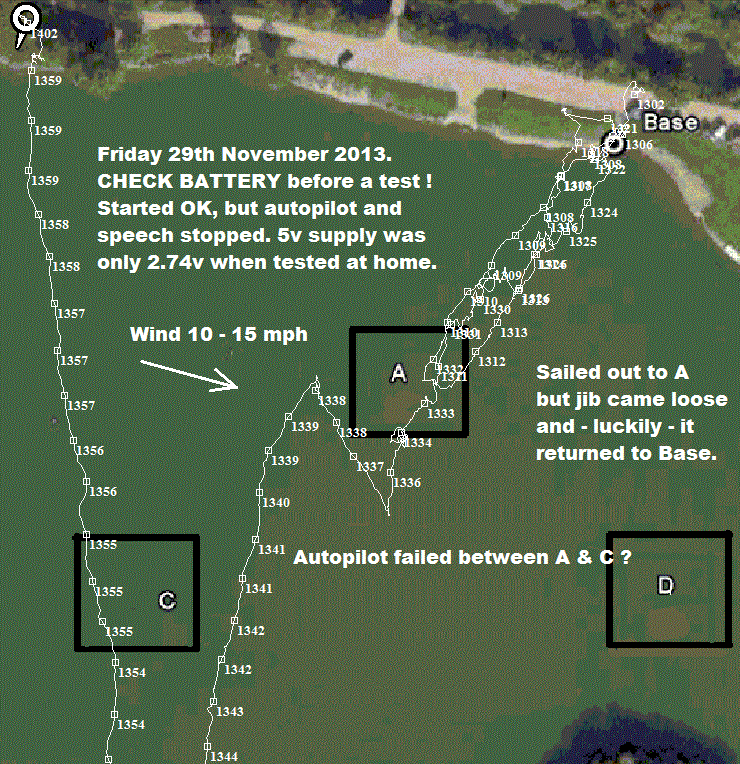 Friday 15th November: We hoped for a decent wind, but conditions were VERY light, at between only 0 to 5 mph from the North.
Mainsail and jib were set at about 40 degrees, and the 5v batteries were not flat ! Despite the slack conditions,
some zig-zag could still be seen by eye, on video, and this GPS plot on the left. Click on it to see details.
Friday 15th November: We hoped for a decent wind, but conditions were VERY light, at between only 0 to 5 mph from the North.
Mainsail and jib were set at about 40 degrees, and the 5v batteries were not flat ! Despite the slack conditions,
some zig-zag could still be seen by eye, on video, and this GPS plot on the left. Click on it to see details.
Saturday 30th November: Note on flat 5v batteries:
Since 1st July, the SPOT tracker drains about 18.5mA from the main 5v supply, which has a capacity of about
4800mAH, even when the autopilot is switched OFF. So, if the boat is not receiving much light - as when in winter,
and indoors near a patio door - the main 5v batteries might go flat after about 10 days. Hence the need to check voltage,
before a trip to Bray Lake. The duplicated batteries have been recharged, and are being monitored to confirm the estimate
of 10 days above.

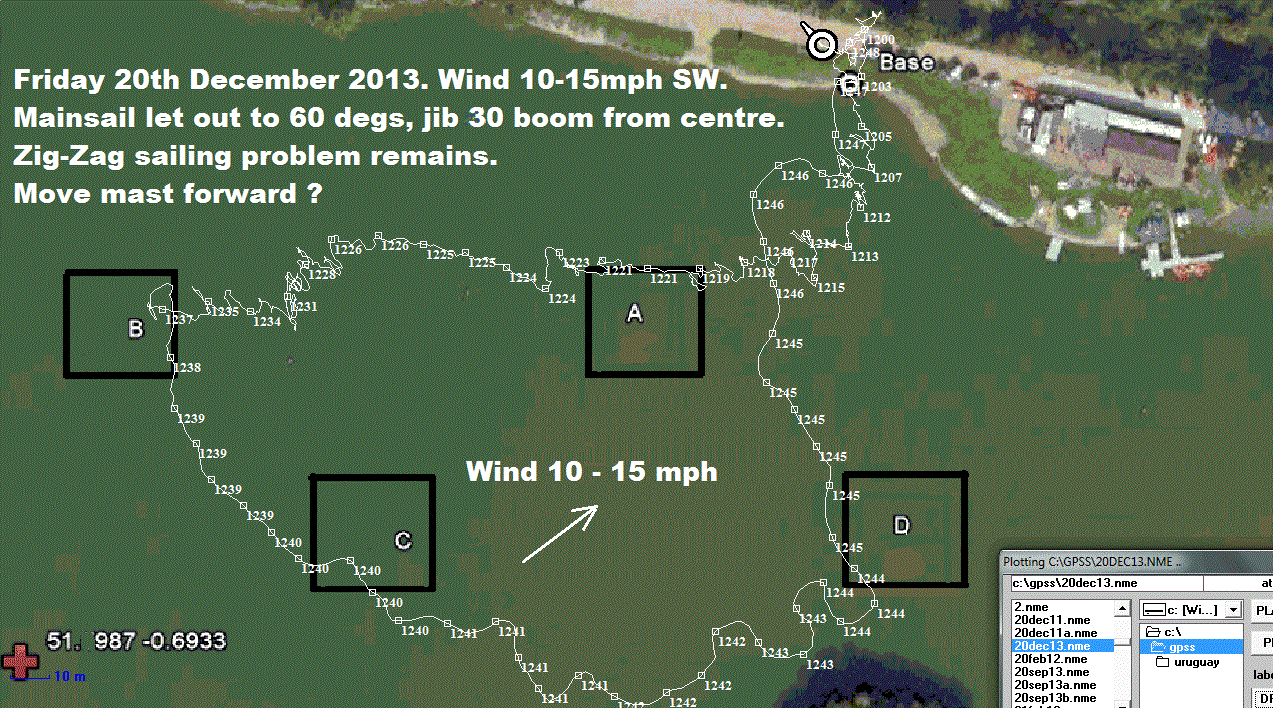 Friday 6th December: the battery tests confirmed our estimate of how long the batteries would last with the autopilot off.
e.g. after 6 days we still had over 4.75v main power - but the batteries were given a boost before today's sail - to be sure !
The details of the test can be seen by clicking on the GPS plot on the left. In brief: the zig-zag sailing problem remains,
so more thinking and testing is needed !
Friday 6th December: the battery tests confirmed our estimate of how long the batteries would last with the autopilot off.
e.g. after 6 days we still had over 4.75v main power - but the batteries were given a boost before today's sail - to be sure !
The details of the test can be seen by clicking on the GPS plot on the left. In brief: the zig-zag sailing problem remains,
so more thinking and testing is needed !
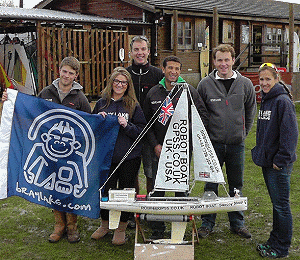
 Saturday 21st December: June has popped out again for more food shopping, so I don't need to look busy
tidying up the games room before Christmas. I call it the "games room" - June calls it the "dining room".
I've moved the mast forward about 10cm, from where it was, about halfway between where the mast is now,
and where the string from the mainsail ties to the deck: now marked by an extra Snoopy Viking figure !
See the picture on the right.
Saturday 21st December: June has popped out again for more food shopping, so I don't need to look busy
tidying up the games room before Christmas. I call it the "games room" - June calls it the "dining room".
I've moved the mast forward about 10cm, from where it was, about halfway between where the mast is now,
and where the string from the mainsail ties to the deck: now marked by an extra Snoopy Viking figure !
See the picture on the right.
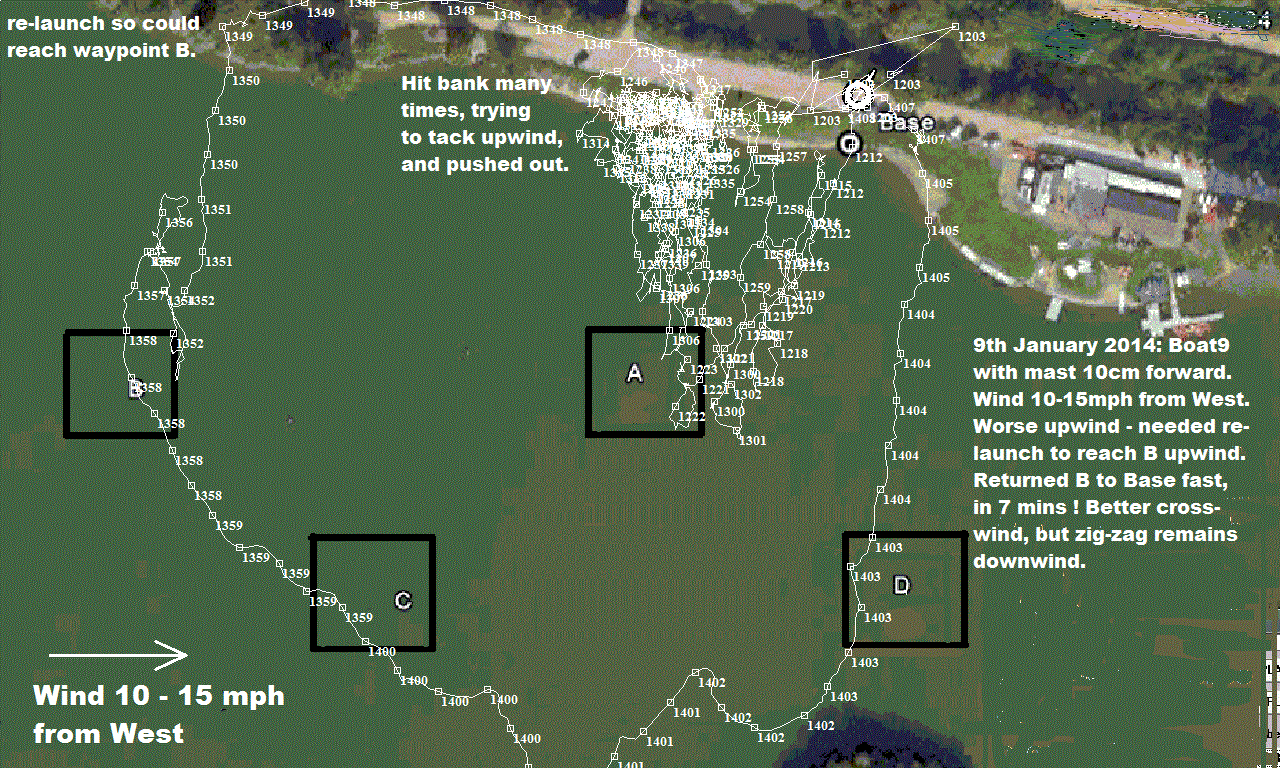 Thursday 9th January: a very useful test on Bray Lake - but a very long one: 1.75 hours before Snoopy made it upwind to waypoint B,
against a good breeze of 10 to 15mph from the West. Snoopy kept tacking into the north bank, near the Bungee jump spot, and so Robin
used the long telescopic pole to push him out again. Eventually, we re-launched him from further west, and then he quickly got out
to waypoint B, not having to go directly upwind. He then came all the way back, through waypoints C and D to Base, within 6 minutes !
It seems moving the mast forward has made most sailing directions straighter, but we still have the "zig-zag" directly downwind.
It also seems that upwind progress suffers - and that was to be expected. Click on the GPS plot on right to see the detail.
Thursday 9th January: a very useful test on Bray Lake - but a very long one: 1.75 hours before Snoopy made it upwind to waypoint B,
against a good breeze of 10 to 15mph from the West. Snoopy kept tacking into the north bank, near the Bungee jump spot, and so Robin
used the long telescopic pole to push him out again. Eventually, we re-launched him from further west, and then he quickly got out
to waypoint B, not having to go directly upwind. He then came all the way back, through waypoints C and D to Base, within 6 minutes !
It seems moving the mast forward has made most sailing directions straighter, but we still have the "zig-zag" directly downwind.
It also seems that upwind progress suffers - and that was to be expected. Click on the GPS plot on right to see the detail.
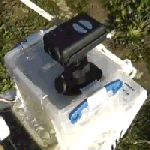 The big step forward was addition of a low cost Mobius video camera (on left), and we have a new video to prove it.
This "deck camera" provides excellent HD quality video,
with sound. You can just about hear the computer speaking above the splashing of waves and wind noise. You will even hear me shouting
from the bank. I'm looking forward to hearing what profanities the other sailors say, during close approaches :-)
The big step forward was addition of a low cost Mobius video camera (on left), and we have a new video to prove it.
This "deck camera" provides excellent HD quality video,
with sound. You can just about hear the computer speaking above the splashing of waves and wind noise. You will even hear me shouting
from the bank. I'm looking forward to hearing what profanities the other sailors say, during close approaches :-)
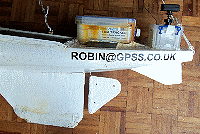 Sunday 12th January: Yesterday I received an email from my local expert Roger, suggesting the rudder should be
at the back - as on last year's boat8 - and protected by a "skeg". This was on my "list of things to try", as you
will see from my comparison of boats 8 and 9 above (21st December). That evening, I made the skeg from plywood, covered in fastglass
resin, and fixed it at the back, with a carbon-fibre rod, before painting it and allowing it to dry overnight.
In the longer term, we might move the rudder back, but that would be a more substantial task. Hopefully, some
more Bray Lake tests will show what effect the skeg has on the zig-zag sailing. It is expected that the existing rudder
will be sufficient to turn the boat. The mast will be moved back to the original position, so that the new GPS track
can be compared with the many others above.
Sunday 12th January: Yesterday I received an email from my local expert Roger, suggesting the rudder should be
at the back - as on last year's boat8 - and protected by a "skeg". This was on my "list of things to try", as you
will see from my comparison of boats 8 and 9 above (21st December). That evening, I made the skeg from plywood, covered in fastglass
resin, and fixed it at the back, with a carbon-fibre rod, before painting it and allowing it to dry overnight.
In the longer term, we might move the rudder back, but that would be a more substantial task. Hopefully, some
more Bray Lake tests will show what effect the skeg has on the zig-zag sailing. It is expected that the existing rudder
will be sufficient to turn the boat. The mast will be moved back to the original position, so that the new GPS track
can be compared with the many others above.

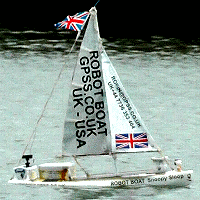
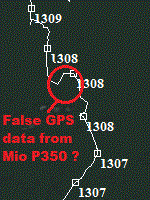
 Wednesday 15th January: Today was a huge surprise: it seems that the "zig-zag" problem may not be such a big problem
as we thought. The main culprit seems to be the quality of GPS data recorded by the Mio P350 Pocket PC. We do have
a zig-zag which we need to fix, but it seems our GPS plots show "wobbles" which are simply not there. It was
the new Mobius deck camera which showed this clearly. The pictures here show what we discovered. The first two
on the left show what we saw from our Base, and a close-up of the bad GPS data. Click on the map on right
for all the GPS plot. Below is from the Mobius deck camera, when Snoopy was heading directly towards us.
Below that is from when he was heading furthest to the left: maybe 80 degrees instead of twice that !
Robin can be seen near the base, near the car, and John, walking back from the clubhouse.
Wednesday 15th January: Today was a huge surprise: it seems that the "zig-zag" problem may not be such a big problem
as we thought. The main culprit seems to be the quality of GPS data recorded by the Mio P350 Pocket PC. We do have
a zig-zag which we need to fix, but it seems our GPS plots show "wobbles" which are simply not there. It was
the new Mobius deck camera which showed this clearly. The pictures here show what we discovered. The first two
on the left show what we saw from our Base, and a close-up of the bad GPS data. Click on the map on right
for all the GPS plot. Below is from the Mobius deck camera, when Snoopy was heading directly towards us.
Below that is from when he was heading furthest to the left: maybe 80 degrees instead of twice that !
Robin can be seen near the base, near the car, and John, walking back from the clubhouse.

From deck camera when Snoopy was heading furthest away from his correct course ...

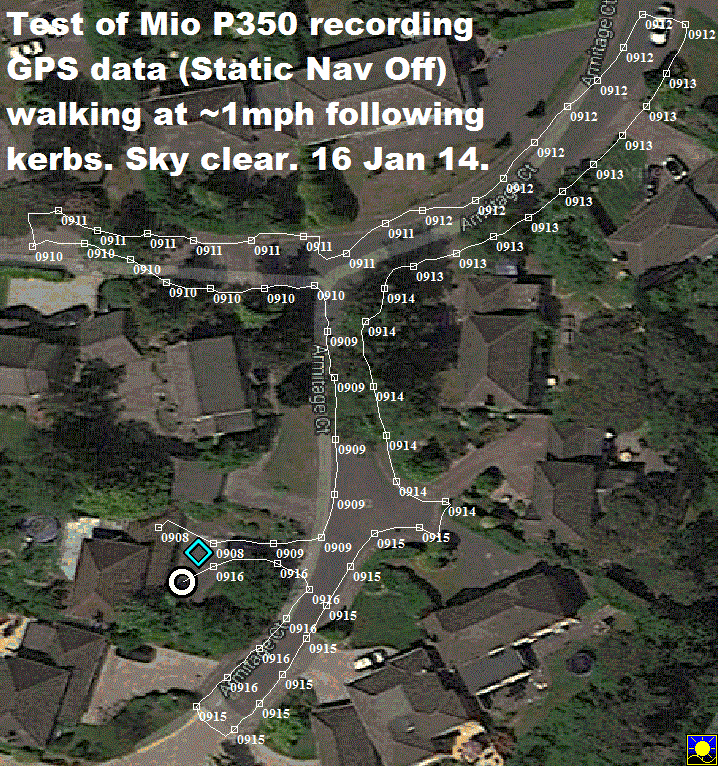 Thursday 16th January: The Mio P350 Pocket PC was tested, recording GPS data, while walking slowly
at about 1 mph, around the road and driveways near home. Click on the GPS plot on the right,
to see the detail. It took a few minutes, after switching on, for GPS errors to settle from
typically 10 or 20 metres, to nearer 3 metres or less. The GPS track followed the path trodden,
along the kerbs, holding the GPS by hand. The cause of innacuracy of GPS tracks recorded on Bray Lake
is not known yet, and could be due to a variety of factors, including interference from nearby
equiment, such as the FM transmitter, effects of the boats movement, and weather conditions including rain and cloud.
However, this test confirmed that the Mio P350 seems suitable for the job - but we will also check the videos
more carefully in future ;-)
Thursday 16th January: The Mio P350 Pocket PC was tested, recording GPS data, while walking slowly
at about 1 mph, around the road and driveways near home. Click on the GPS plot on the right,
to see the detail. It took a few minutes, after switching on, for GPS errors to settle from
typically 10 or 20 metres, to nearer 3 metres or less. The GPS track followed the path trodden,
along the kerbs, holding the GPS by hand. The cause of innacuracy of GPS tracks recorded on Bray Lake
is not known yet, and could be due to a variety of factors, including interference from nearby
equiment, such as the FM transmitter, effects of the boats movement, and weather conditions including rain and cloud.
However, this test confirmed that the Mio P350 seems suitable for the job - but we will also check the videos
more carefully in future ;-)
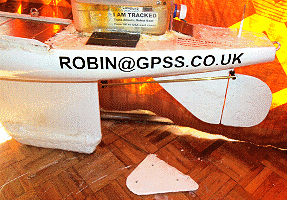 Friday 17th January: Yes, we are now moving the rudder to the back, protected by a skeg.
This was on our list of things to try, but was a bigger job than simply adjusting the sails
or making the existing rudder bigger. Both John and Roger suggested that our old rudder - on the floor here
- would not work as well as where the rudder has always been on a marblehead - at the back !
The Mobius deck camera came up trumps again: I watched and listened to the video recorded on Wednesday.
I could clearly hear the computer saying, repeatedly, things like "(steer) 90 (degrees) left", but the boat
only temporarily twitching a few degrees. Eventually the boat might turn onto it's required heading,
but this is probably the effect of the "rudder trim logic" kicking in. Ideally, a big error in direction,
such as 90 degrees, should result in tens of degrees of movement, on each "nudge" in the 7 second autopilot cycle.
Friday 17th January: Yes, we are now moving the rudder to the back, protected by a skeg.
This was on our list of things to try, but was a bigger job than simply adjusting the sails
or making the existing rudder bigger. Both John and Roger suggested that our old rudder - on the floor here
- would not work as well as where the rudder has always been on a marblehead - at the back !
The Mobius deck camera came up trumps again: I watched and listened to the video recorded on Wednesday.
I could clearly hear the computer saying, repeatedly, things like "(steer) 90 (degrees) left", but the boat
only temporarily twitching a few degrees. Eventually the boat might turn onto it's required heading,
but this is probably the effect of the "rudder trim logic" kicking in. Ideally, a big error in direction,
such as 90 degrees, should result in tens of degrees of movement, on each "nudge" in the 7 second autopilot cycle.
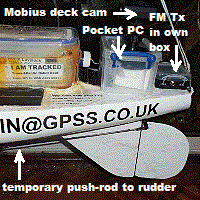 The new rudder and skeg did not take too long to make, in the usual way, and was ready to fit this morning.
Forgive the crude approach adopted for the first sailing tests: the old rudder was replaced by a carbon fibre rod
"drive shaft", which will be linked by a push rod, to a lever on the new rudder. See left: a bit of brass tube
marks where the push rod will go. This can easily be adjusted during tests on Bray Lake, experimenting
with things like decreased rudder throw. However, it is obviously very unsuitable in the longer term,
since it is asking to snag weed or get damaged. You can see the new rudder post extending up above
the deck, and we have yet to decide how to change things like the existing "lunchbox" and/or
the optional box (removed here) to hold test equipment, such as the Pocket PC and FM Transmitter.
The new rudder and skeg did not take too long to make, in the usual way, and was ready to fit this morning.
Forgive the crude approach adopted for the first sailing tests: the old rudder was replaced by a carbon fibre rod
"drive shaft", which will be linked by a push rod, to a lever on the new rudder. See left: a bit of brass tube
marks where the push rod will go. This can easily be adjusted during tests on Bray Lake, experimenting
with things like decreased rudder throw. However, it is obviously very unsuitable in the longer term,
since it is asking to snag weed or get damaged. You can see the new rudder post extending up above
the deck, and we have yet to decide how to change things like the existing "lunchbox" and/or
the optional box (removed here) to hold test equipment, such as the Pocket PC and FM Transmitter.
 We will come to that after testing if this new rudder solves our zig-zag problem, and improves the sailing capability.
We will come to that after testing if this new rudder solves our zig-zag problem, and improves the sailing capability.
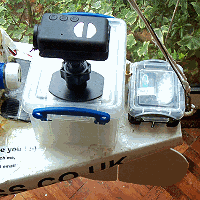 Saturday 18th January: We may have improved the GPS tracks recorded by the Mio P350, by use of GPSView to set
the $GPRMC message rate from every 1 second, to every 6 seconds. Here, on the left, is a test plot walking the same path near home.
Click on it to see the details. On the right is a closeup of the deck camera and test equipment boxes, including that of the FM transmitter,
the FM aerial goes up the rear stay, as before, but then is held vertical by the plastic tube.
Saturday 18th January: We may have improved the GPS tracks recorded by the Mio P350, by use of GPSView to set
the $GPRMC message rate from every 1 second, to every 6 seconds. Here, on the left, is a test plot walking the same path near home.
Click on it to see the details. On the right is a closeup of the deck camera and test equipment boxes, including that of the FM transmitter,
the FM aerial goes up the rear stay, as before, but then is held vertical by the plastic tube.
 Tuesday 21st January: New sails arrived by post from Frank at Nylet. These were ordered last year as "spares",
but Frank was able to use a better approach to make them opaque, so the lettering could easily be read
from both sides, including when lit from behind. He has used double thickness material, as a "sandwich"
and sprayed the inside surfaces with silver spay paint. I've put on the lettering, either side, on the jib,
and this confirms that the method works. Hopefully the letters stay on, as well as with our earlier method,
where sticky plastc sheet was added - see details of existing sails on the
design page, under "6. the Rig, including Sails, Mast and Sail Booms ...".
For now we will stick with these old sails, that have
survived OK for over a year now, including many weeks of 24/7 testing on Bray Lake, and three
eventful dips in the sea during 2013. The new sails will be completed, with their flags and lettering,
then we will start testing them on Bray Lake.
Tuesday 21st January: New sails arrived by post from Frank at Nylet. These were ordered last year as "spares",
but Frank was able to use a better approach to make them opaque, so the lettering could easily be read
from both sides, including when lit from behind. He has used double thickness material, as a "sandwich"
and sprayed the inside surfaces with silver spay paint. I've put on the lettering, either side, on the jib,
and this confirms that the method works. Hopefully the letters stay on, as well as with our earlier method,
where sticky plastc sheet was added - see details of existing sails on the
design page, under "6. the Rig, including Sails, Mast and Sail Booms ...".
For now we will stick with these old sails, that have
survived OK for over a year now, including many weeks of 24/7 testing on Bray Lake, and three
eventful dips in the sea during 2013. The new sails will be completed, with their flags and lettering,
then we will start testing them on Bray Lake.
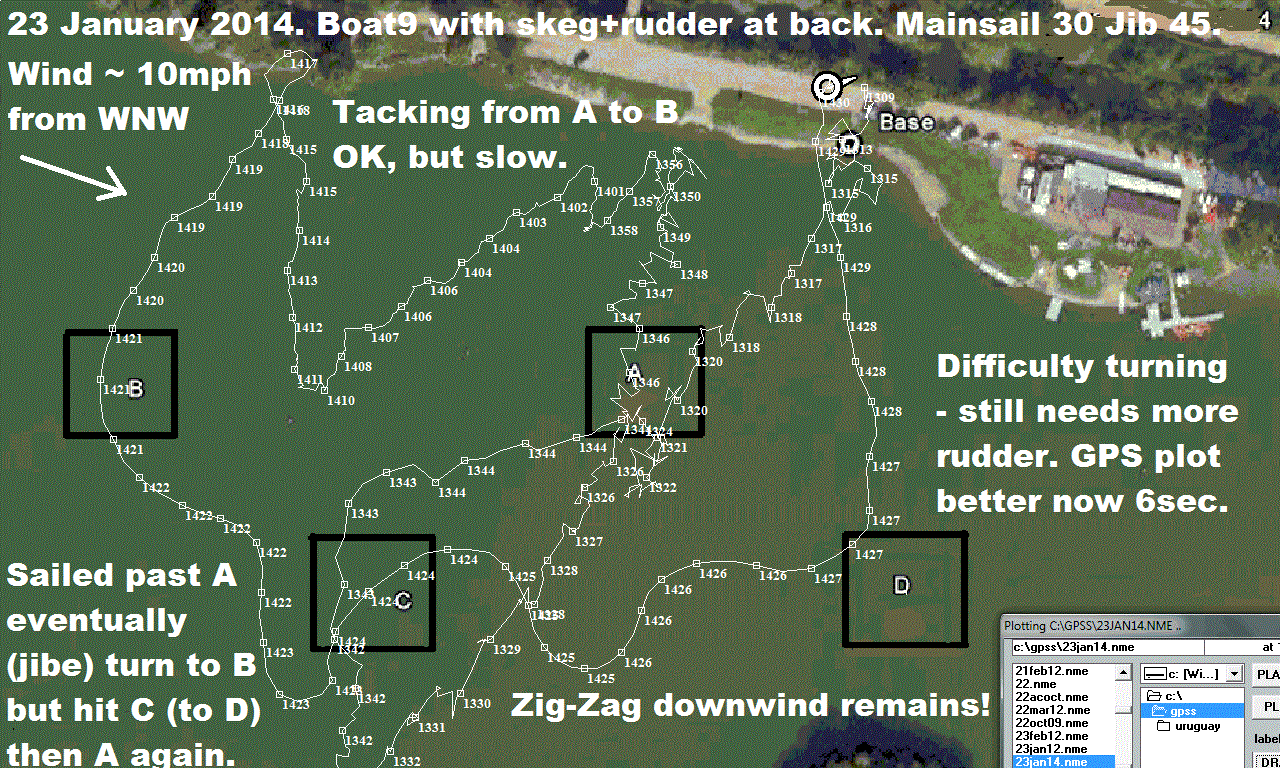 Thursday 23rd January: First test with rudder at the very back: click on the GPS plot on the right, to see the details. In brief: the zig-zag sailing downwind
was as bad as ever, and both GPS plot and our videos show that the rudder is not having enough effect. It's possible
that the skeg - needed to protect the rear rudder - slows down how fast the boat can turn. We will see how best
to increase rudder effect for our next test. Wind was about 10mph from the WNW, shifting occasionally to from the West.
This strange GPS plot was due to the boat not turning right after reaching waypoint A, eventually turning (after an accidental jibe),
then hitting C by accident. It then aimed for D, but hit A by accident ! From then it continued as it should.
The FM transmitter had less range - we will try a shorter aerial. The Mobius deck camera worked well, recording 40 minutes
of video and autopilot speech, before it's internal battery went flat. It still had nearly 50% of it's 8GB memory free.
Maybe we will give it external power soon. The GPS plot, recording points every 6 secs instead of every second, seemed
more realistic.
Thursday 23rd January: First test with rudder at the very back: click on the GPS plot on the right, to see the details. In brief: the zig-zag sailing downwind
was as bad as ever, and both GPS plot and our videos show that the rudder is not having enough effect. It's possible
that the skeg - needed to protect the rear rudder - slows down how fast the boat can turn. We will see how best
to increase rudder effect for our next test. Wind was about 10mph from the WNW, shifting occasionally to from the West.
This strange GPS plot was due to the boat not turning right after reaching waypoint A, eventually turning (after an accidental jibe),
then hitting C by accident. It then aimed for D, but hit A by accident ! From then it continued as it should.
The FM transmitter had less range - we will try a shorter aerial. The Mobius deck camera worked well, recording 40 minutes
of video and autopilot speech, before it's internal battery went flat. It still had nearly 50% of it's 8GB memory free.
Maybe we will give it external power soon. The GPS plot, recording points every 6 secs instead of every second, seemed
more realistic.
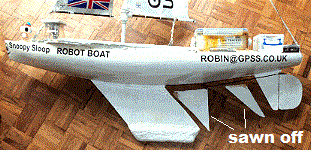 This was on our list of things to try - get out the saw, to reduce the length
of the keel and the skeg, which slow down turning. It should also make it easier to turn into wind.
We've also increased rudder throw from about 40 to 60 degrees maximum, by moving the rear linkage in by two holes.
Other alternatives included changing a number in the software, so, at above one knot, the rudder is held over
for 4.5 secs instead of 1.5 secs. The software change was easy, and is ready if we need it - but then I saw
the autopilot picaxe was encapsulated - so that would mean replacement and getting the soldering iron out !
This was on our list of things to try - get out the saw, to reduce the length
of the keel and the skeg, which slow down turning. It should also make it easier to turn into wind.
We've also increased rudder throw from about 40 to 60 degrees maximum, by moving the rear linkage in by two holes.
Other alternatives included changing a number in the software, so, at above one knot, the rudder is held over
for 4.5 secs instead of 1.5 secs. The software change was easy, and is ready if we need it - but then I saw
the autopilot picaxe was encapsulated - so that would mean replacement and getting the soldering iron out !
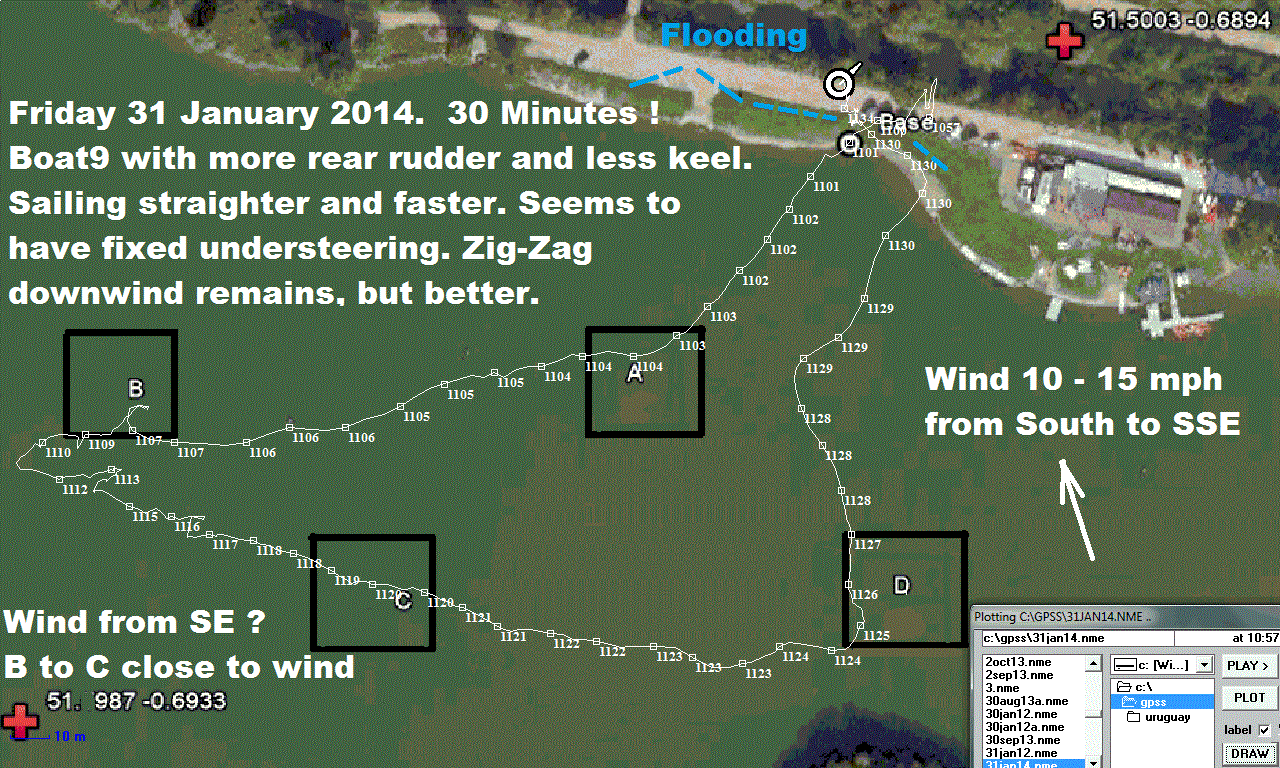 However, it did prompt me to update documentation of the software on the
design page - on what these numbers have been, months before we last changed boat9's
software - almost exactly a year ago ! We will see what effect these changes have on improved steering. It is possible that
we exploit the new keel to go back to our original rudder position, but with a larger, balanced rudder.
However, it did prompt me to update documentation of the software on the
design page - on what these numbers have been, months before we last changed boat9's
software - almost exactly a year ago ! We will see what effect these changes have on improved steering. It is possible that
we exploit the new keel to go back to our original rudder position, but with a larger, balanced rudder.
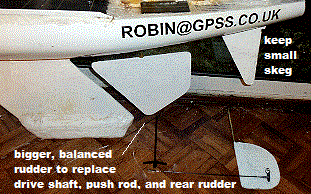 Friday 31st January at 1630: Great Progress! :-) Snoopy completed the Bray Lake Test in just 30 minutes ! We had to wait for a day
with a decent breeze, and this was it - before the rain arrived. Click on the GPS plot on the right to see the details.
It seems the increased rudder movement and shorter keel have overcome the "understeering" problem.
Friday 31st January at 1630: Great Progress! :-) Snoopy completed the Bray Lake Test in just 30 minutes ! We had to wait for a day
with a decent breeze, and this was it - before the rain arrived. Click on the GPS plot on the right to see the details.
It seems the increased rudder movement and shorter keel have overcome the "understeering" problem.
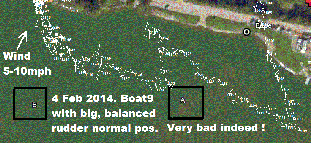
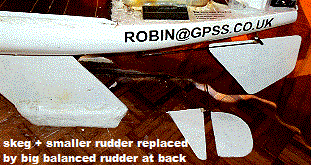 Tuesday 4th February: that bigger, balanced rudder, in it's normal, forward position gave terrible steering
- as you can see from the GPS plot on the left. No point in giving you the more detailed version of it.
Wind was only 5 to 10 mph from SW or SSW, but should have been enough. The "voyage" took an hour,
and you could hear the computer trying to turn left or right, without success, for tens of minutes.
Eventually it got snagged in trees, and we had a rescue using a paddle board. We could test this again,
but it seems to make more sense, to swap things around, and try the bigger, balanced rudder at the back (see right).
Tuesday 4th February: that bigger, balanced rudder, in it's normal, forward position gave terrible steering
- as you can see from the GPS plot on the left. No point in giving you the more detailed version of it.
Wind was only 5 to 10 mph from SW or SSW, but should have been enough. The "voyage" took an hour,
and you could hear the computer trying to turn left or right, without success, for tens of minutes.
Eventually it got snagged in trees, and we had a rescue using a paddle board. We could test this again,
but it seems to make more sense, to swap things around, and try the bigger, balanced rudder at the back (see right).
 The Mio based GPS logging and Mobius camera continued
to work perfectly. Minor faults surfaced, such as the rudder linkage failing, due to wear
on the temporary carbon fibre drive shaft. We could test again, with a different wind direction,
but maybe it is time for a general "tidy up" on the boat. e.g. shift the lunchbox aft, so it covers
the new rudder post position, and we can remove that untidy drive shaft and push rod.
e.g. strip out the hull contents, to remove unused batteries and water. Weight is now 15.6kg,
and it will be good if we can bring the weight down closer to the original 12.3kg a year ago
(see
blog1 for when the weight crept up during 2013).
The Mio based GPS logging and Mobius camera continued
to work perfectly. Minor faults surfaced, such as the rudder linkage failing, due to wear
on the temporary carbon fibre drive shaft. We could test again, with a different wind direction,
but maybe it is time for a general "tidy up" on the boat. e.g. shift the lunchbox aft, so it covers
the new rudder post position, and we can remove that untidy drive shaft and push rod.
e.g. strip out the hull contents, to remove unused batteries and water. Weight is now 15.6kg,
and it will be good if we can bring the weight down closer to the original 12.3kg a year ago
(see
blog1 for when the weight crept up during 2013).
 All parts, including navigation light and
solar panels, need to be tested and repaired where neccesary. It was important to use the right tools for the work:
e.g. Junes kitchen scales, baster, measuring jug, and carving knife.
All parts, including navigation light and
solar panels, need to be tested and repaired where neccesary. It was important to use the right tools for the work:
e.g. Junes kitchen scales, baster, measuring jug, and carving knife.
Wednesday 12th February: the two main 5v Solar Panels needed major rework, including replacing 6 of the 8
blocking diodes. The two assemblies were rewired and rejoined with fast-glass resin, then sealed with varnish.
One small panel, for the I-GotU, was OK, but both small panels for the SPOT were replaced by a single larger
panel.
The new "lunchbox" is taking shape, with the inner plywood, holding the rudder servo and SPOT Messenger.
 Thursday 13th February: the deck layout is being modified, as seen on the left: the navigation light
will be at the back: probably a lower power, Homebase "SOFT GLOW GARDEN SOLAR LIGHT", at £6, which
needs to be tested for range, but works all night without modification. The solar panel at the front, behind Snoopy,
is for the SPOT power; then the two main solar panels, in their usual position; then the removeable box of test
equipment, including Mobius camera - which should get a better view forward, including Snoopy. A small solar panel,
for the I-GotU GPS logger, is behind the new "lunchbox" holding the SPOT tracker, autopilot and rudder servo.
Thursday 13th February: the deck layout is being modified, as seen on the left: the navigation light
will be at the back: probably a lower power, Homebase "SOFT GLOW GARDEN SOLAR LIGHT", at £6, which
needs to be tested for range, but works all night without modification. The solar panel at the front, behind Snoopy,
is for the SPOT power; then the two main solar panels, in their usual position; then the removeable box of test
equipment, including Mobius camera - which should get a better view forward, including Snoopy. A small solar panel,
for the I-GotU GPS logger, is behind the new "lunchbox" holding the SPOT tracker, autopilot and rudder servo.
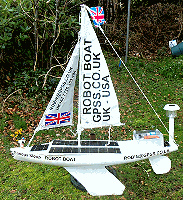
 Thursday 20th February: The rebuild is practically complete, and the boat now weighs 13.25 kg, without the
Pocket PC and Mobius camera only used for testing - which add just 0.3kg. A vertical white PVC tube at the rear
will take the navigation lamp - currently the £6 Homebase "Soft Glow" product that weighes just 0.15kg, compared with 0.45kg
for the "Superbright" product (now £25) - both of which run without additional solar panels. The old, modified, lamp weighed
0.35kg. We can decide what lamp to use, if we use one, later, after range tests. The new "FIBOX TA201610T Enclosure"
seems an ideal alternative to the original "lunchbox", with similar dimensions but a little more "headroom".
A very similar layout has been used, but with a tidier approach to the wiring - wires soldered between brass screws,
with futaba connectors only used for testing. e.g. out of autopilot and into rudder servo. Note that "tidy"
is a relative term :-) The circuits used are similar, but slightly different from the original.
e.g. for the SPOT, a single 3.6v supply, based on 3x NiMH cells, is charged from the 6v panel
at the very front, but is "clamped" by 3.7v zenar diodes ( 3 in parallel). In addition, there
is a "trickle" from the main 5v supply through a 11ohm resistor, then two series diodes to drop 1.4 volt.
This seems safer than the single diode and 65 ohm mentioned in
Blog1
for 1st July 2013.
We will keep an eye on main 5v and 3.6v levels in the coming days.
Thursday 20th February: The rebuild is practically complete, and the boat now weighs 13.25 kg, without the
Pocket PC and Mobius camera only used for testing - which add just 0.3kg. A vertical white PVC tube at the rear
will take the navigation lamp - currently the £6 Homebase "Soft Glow" product that weighes just 0.15kg, compared with 0.45kg
for the "Superbright" product (now £25) - both of which run without additional solar panels. The old, modified, lamp weighed
0.35kg. We can decide what lamp to use, if we use one, later, after range tests. The new "FIBOX TA201610T Enclosure"
seems an ideal alternative to the original "lunchbox", with similar dimensions but a little more "headroom".
A very similar layout has been used, but with a tidier approach to the wiring - wires soldered between brass screws,
with futaba connectors only used for testing. e.g. out of autopilot and into rudder servo. Note that "tidy"
is a relative term :-) The circuits used are similar, but slightly different from the original.
e.g. for the SPOT, a single 3.6v supply, based on 3x NiMH cells, is charged from the 6v panel
at the very front, but is "clamped" by 3.7v zenar diodes ( 3 in parallel). In addition, there
is a "trickle" from the main 5v supply through a 11ohm resistor, then two series diodes to drop 1.4 volt.
This seems safer than the single diode and 65 ohm mentioned in
Blog1
for 1st July 2013.
We will keep an eye on main 5v and 3.6v levels in the coming days.
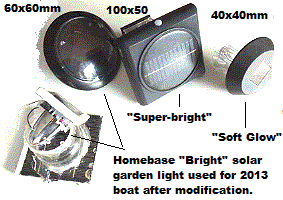
 Friday 21st February: Tests have started in the garden, and I expect first sailing tests on Bray Lake
next week. The picture on left shows three Homebase solar garden light products, with different characteristics,
such as weight, brighness, and ability to stay on all night without modification - such as addition of a solar panel.
We may shorten the rear vertical tube, since the weight and wind-resistance of the lamp are undesirables.
I'm now on the lookout for white anti-fouling paint, after seeing the picture, on right, of an American boat,
launched by school children (with GPS but no Autopilot) that crossed the Atlantic and has just been found
- encrusted by barnicles. You can read the BBC news article by
clicking on the picture of Paris Broe-Bougourd, who found the boat.
Friday 21st February: Tests have started in the garden, and I expect first sailing tests on Bray Lake
next week. The picture on left shows three Homebase solar garden light products, with different characteristics,
such as weight, brighness, and ability to stay on all night without modification - such as addition of a solar panel.
We may shorten the rear vertical tube, since the weight and wind-resistance of the lamp are undesirables.
I'm now on the lookout for white anti-fouling paint, after seeing the picture, on right, of an American boat,
launched by school children (with GPS but no Autopilot) that crossed the Atlantic and has just been found
- encrusted by barnicles. You can read the BBC news article by
clicking on the picture of Paris Broe-Bougourd, who found the boat.
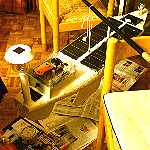 Saturday 22nd February: today I purchased a small tin of "International TRILUX 33" white anti-fouling paint, at £25,
from the very helpful Chertsey Marina. Here, on the right, is the first coat drying, with the boat suspended from a pole
between two chairs. The Left Hand Side (LHS) of the duplicated main 5v supply was running low,
so the 5v battery was changed for a new 2600mAH pack. The autopilot is now on 24/7, with the boat outside
during daylight hours, to test the main 5v and 3.5v solar power systems.
Saturday 22nd February: today I purchased a small tin of "International TRILUX 33" white anti-fouling paint, at £25,
from the very helpful Chertsey Marina. Here, on the right, is the first coat drying, with the boat suspended from a pole
between two chairs. The Left Hand Side (LHS) of the duplicated main 5v supply was running low,
so the 5v battery was changed for a new 2600mAH pack. The autopilot is now on 24/7, with the boat outside
during daylight hours, to test the main 5v and 3.5v solar power systems.
 I've purchased two more types of solar garden lamp to compare with the three products above,
and found somewhere we might use for range tests.
I've purchased two more types of solar garden lamp to compare with the three products above,
and found somewhere we might use for range tests.
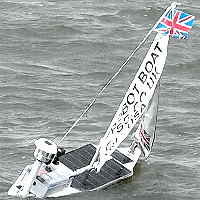 Tuesday 25th February: the first sail after the "tidy-up" had to be aborted, due to heavy rain showers and
silly things needing to be fixed, that I should have seen before leaving home ! e.g. the Mobius camera,
in the new position, is knocked by the main sail boom. Also, the navigation light was not secured tightly,
and this fell off - along with the FM transmitter that had been "elastic-banded" to it ! The boat was
- as to be expected - struggling to get away from the bank, in a 15mph wind from the South. Rudder movement
was more than adequate, and could be reduced a little, relying on some "automatic rudder trim" (now done,
by moving servo clevis into next hole).
The boat weighed 13.25kg+0.5kg of test equipment. The "fixes" were simple. e.g. replace the box that the Mobius stands on,
for a lower one, still big enough for the Pocket PC (now done). The boat is now ready, when the weather is ! :-)
Tuesday 25th February: the first sail after the "tidy-up" had to be aborted, due to heavy rain showers and
silly things needing to be fixed, that I should have seen before leaving home ! e.g. the Mobius camera,
in the new position, is knocked by the main sail boom. Also, the navigation light was not secured tightly,
and this fell off - along with the FM transmitter that had been "elastic-banded" to it ! The boat was
- as to be expected - struggling to get away from the bank, in a 15mph wind from the South. Rudder movement
was more than adequate, and could be reduced a little, relying on some "automatic rudder trim" (now done,
by moving servo clevis into next hole).
The boat weighed 13.25kg+0.5kg of test equipment. The "fixes" were simple. e.g. replace the box that the Mobius stands on,
for a lower one, still big enough for the Pocket PC (now done). The boat is now ready, when the weather is ! :-)
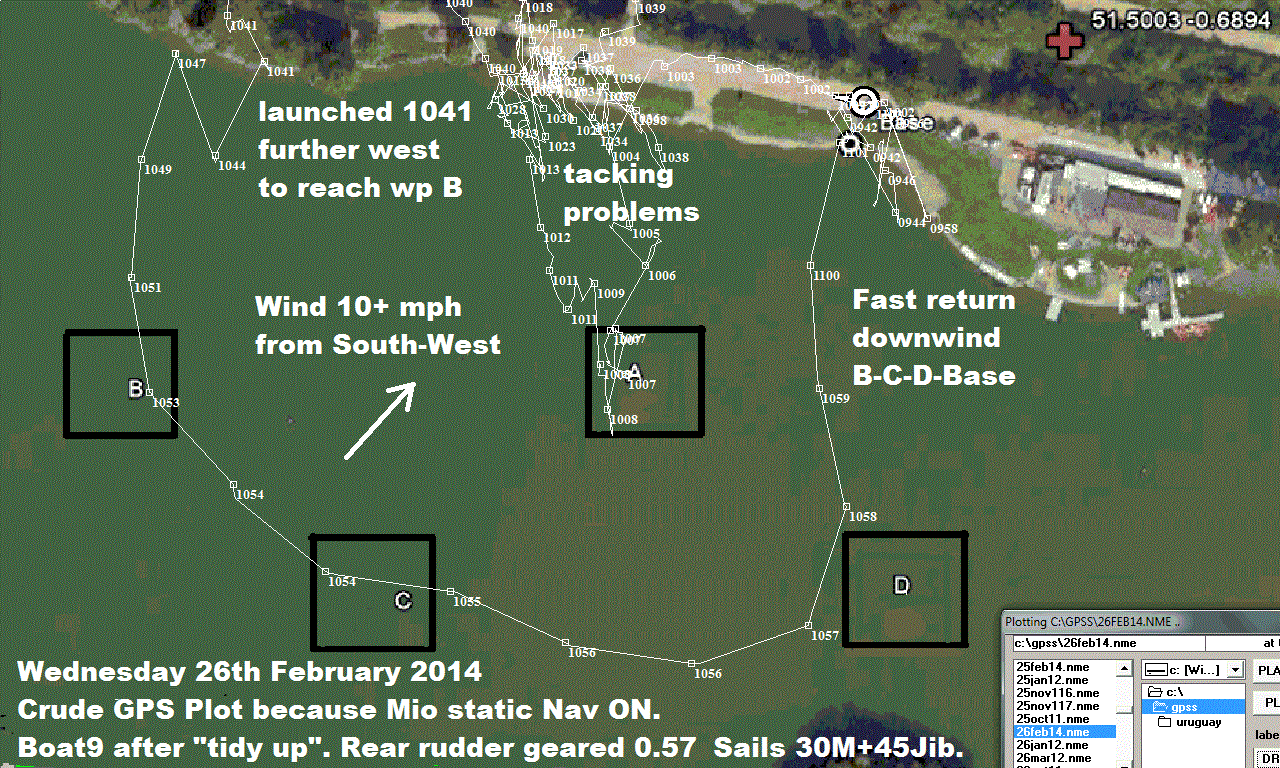 Wednesday 26th February: Click on the GPS plot on the left, to see it more clearly.
Today was a more useful sail, despite poor tacking into the 10mph+ wind meant that it took an hour
to reach waypoint B, and that was only achieved by launching from further west, to avoid sailing close to the wind.
By this time, the Mobius deck camera
had almost filled it's 8GB Micro SD card, so we missed the best few minutes at the end. However, this video did last
1 hr 9 mins.
Wednesday 26th February: Click on the GPS plot on the left, to see it more clearly.
Today was a more useful sail, despite poor tacking into the 10mph+ wind meant that it took an hour
to reach waypoint B, and that was only achieved by launching from further west, to avoid sailing close to the wind.
By this time, the Mobius deck camera
had almost filled it's 8GB Micro SD card, so we missed the best few minutes at the end. However, this video did last
1 hr 9 mins.
 All test equipment worked well, other than the Mio Pocket PC, because it was in Static Navigation mode.
i.e. not showing movement less than 30 metres. But it seems the boat returned fast enough. Tests need to be repeated
in a strong, following wind, looking for zig zag. The rudder seemed to have enough effect (maybe too much?) and
gearing, created by the linkage, was 0.57. This can be calculated by the distances from servo and rudder axis,
to the holes in which the linkage clips. From the outside, these distances are 33mm,28,23 and 18mm on the rudder,
and 16mm,13,10,7mm on the servo. So when the linkage is on the 2nd (28mm) hole at the rudder, and 1st (16mm)
hole at the servo, the gearing is 16mm/28mm = 0.57. So if the servo turns 45 degrees, the rudder turns 45x0.57 = 26 degrees.
Another solar garden light arrived, from ebay, called here "5.dull", and we also have "4.string", a string of 50 LED at £10.
Here, on the right, are all five, switching on shortly after 6pm, and ready for a range test.
All test equipment worked well, other than the Mio Pocket PC, because it was in Static Navigation mode.
i.e. not showing movement less than 30 metres. But it seems the boat returned fast enough. Tests need to be repeated
in a strong, following wind, looking for zig zag. The rudder seemed to have enough effect (maybe too much?) and
gearing, created by the linkage, was 0.57. This can be calculated by the distances from servo and rudder axis,
to the holes in which the linkage clips. From the outside, these distances are 33mm,28,23 and 18mm on the rudder,
and 16mm,13,10,7mm on the servo. So when the linkage is on the 2nd (28mm) hole at the rudder, and 1st (16mm)
hole at the servo, the gearing is 16mm/28mm = 0.57. So if the servo turns 45 degrees, the rudder turns 45x0.57 = 26 degrees.
Another solar garden light arrived, from ebay, called here "5.dull", and we also have "4.string", a string of 50 LED at £10.
Here, on the right, are all five, switching on shortly after 6pm, and ready for a range test.
 Thursday 27th February: today's test was in a wind of 10 to 15mph from the west, gusting to maybe 20 or 25.
Click on the GPS plot for the details.
For those interested, there is a 12 minute
youtube video of Snoopy's sail,
or an MP4 version
here.
The only change from yesterday was the jib being
pulled in from 45 to 30 degrees, the same as the mainsail. Also, the Mio Static Nav was switched off, to provide a more detailed plot.
We had to adopt the same tactic of relaunching further west, but this time the Mobius deck camera filmed all but the last minute's
return from D (near the island) to Base. We could see (and measure) the zig-zag clearly. The video showed it was - as expected
- due to the "leverage" of the sails, turning the boat. e.g. if the sails jibe (swing) to the left, the boat turned to the right,
until the rudder was able to make the correction - which might result in a similar effect to the other side. What next ?
Maybe try a
swing rig
?
A swing rig has the mainsail boom extended forward, and the front of the jib is tied to it,
instead of to the prow of the boat - "pointy end" for any lady readers :-)
Thursday 27th February: today's test was in a wind of 10 to 15mph from the west, gusting to maybe 20 or 25.
Click on the GPS plot for the details.
For those interested, there is a 12 minute
youtube video of Snoopy's sail,
or an MP4 version
here.
The only change from yesterday was the jib being
pulled in from 45 to 30 degrees, the same as the mainsail. Also, the Mio Static Nav was switched off, to provide a more detailed plot.
We had to adopt the same tactic of relaunching further west, but this time the Mobius deck camera filmed all but the last minute's
return from D (near the island) to Base. We could see (and measure) the zig-zag clearly. The video showed it was - as expected
- due to the "leverage" of the sails, turning the boat. e.g. if the sails jibe (swing) to the left, the boat turned to the right,
until the rudder was able to make the correction - which might result in a similar effect to the other side. What next ?
Maybe try a
swing rig
?
A swing rig has the mainsail boom extended forward, and the front of the jib is tied to it,
instead of to the prow of the boat - "pointy end" for any lady readers :-)
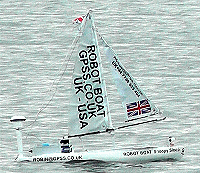 Friday 28th February: Our first test today with a crude swing-rig was done in the lucky situation of a light
5 to 10mph wind from the North-East, which meant that the boat got away quickly, and passed downwind through
waypoints A and B. Major problems then surfaced when it tried to sail cross-wind, which resulted in a rescue being required.
Friday 28th February: Our first test today with a crude swing-rig was done in the lucky situation of a light
5 to 10mph wind from the North-East, which meant that the boat got away quickly, and passed downwind through
waypoints A and B. Major problems then surfaced when it tried to sail cross-wind, which resulted in a rescue being required.
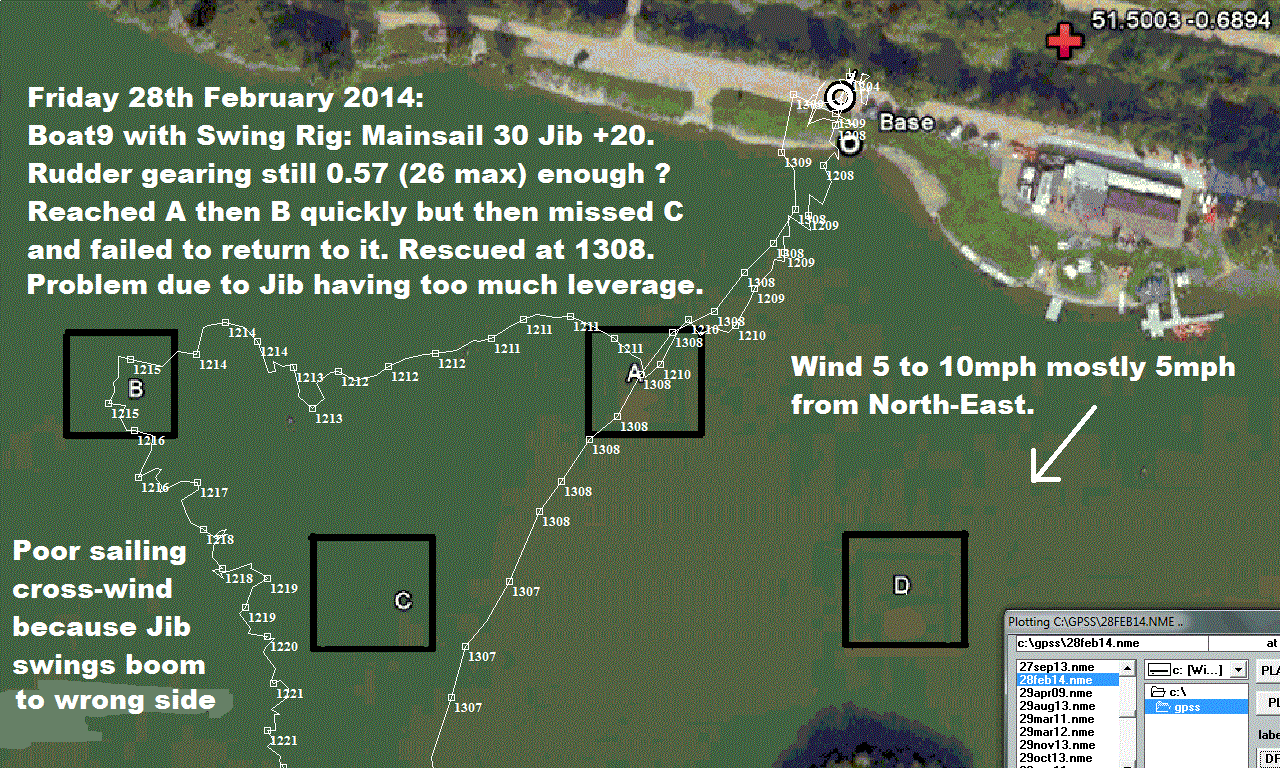 Click on the GPS Plot on the left to see the details. It was the Mobius video that showed what the problem was,
and this was confirmed by
leaf-blower tests
in my back garden. The picture on the right shows the swing rig,
made by tying the front of the jib onto a carbon-fibre tube strapped to the mainsail boom. This is OK for tests,
and if we adopt a swing-rig, we will engineer it better, and also add a front stay, to the prow of the boat.
A sideways wind tends to push the jib back, swinging the mainsail forward - the wrong effect completely!
When sailing downwind, this does not matter. The result is an unbalanced rig, and the boat sailing slower
(less than 1 knot cross-wind, compared with 2 knots downwind), with less rudder steering effect.
After the leaf-blower test, I've let the jib out, from 20 to 40 degrees*, and moved the front back an inch.
We will see if this fixes the problem. * jib then set to 10 degrees.
Click on the GPS Plot on the left to see the details. It was the Mobius video that showed what the problem was,
and this was confirmed by
leaf-blower tests
in my back garden. The picture on the right shows the swing rig,
made by tying the front of the jib onto a carbon-fibre tube strapped to the mainsail boom. This is OK for tests,
and if we adopt a swing-rig, we will engineer it better, and also add a front stay, to the prow of the boat.
A sideways wind tends to push the jib back, swinging the mainsail forward - the wrong effect completely!
When sailing downwind, this does not matter. The result is an unbalanced rig, and the boat sailing slower
(less than 1 knot cross-wind, compared with 2 knots downwind), with less rudder steering effect.
After the leaf-blower test, I've let the jib out, from 20 to 40 degrees*, and moved the front back an inch.
We will see if this fixes the problem. * jib then set to 10 degrees.
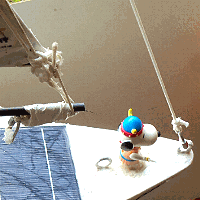 The test equipment worked well - particularly the Mobius, which collected
over an hour of video, including the rescue ! :-)
The test equipment worked well - particularly the Mobius, which collected
over an hour of video, including the rescue ! :-)
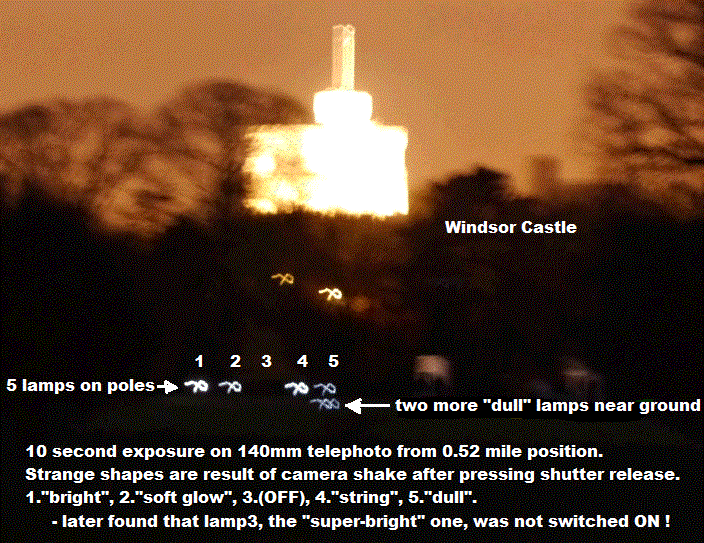 Here, on the left, is one of the photos taken from a range of 0.52 mile (830m). At this range the faintest lights were
just visible with the naked eye, and clearly visible with binoculars. We have yet to test the "super-bright"
product. Today I discovered that it's switch was not in the "ON" position ! :-)
This "test range" near Windsor Castle, should enable tests up to two miles - if you don't mind the walking.
Next time we hope to include the "super-bright" product, and I'll use a remote shutter release to avoid camera shake.
A front stay has been added, so we can use a swing rig, and not rely on the jib being tied to the deck.
Here, on the left, is one of the photos taken from a range of 0.52 mile (830m). At this range the faintest lights were
just visible with the naked eye, and clearly visible with binoculars. We have yet to test the "super-bright"
product. Today I discovered that it's switch was not in the "ON" position ! :-)
This "test range" near Windsor Castle, should enable tests up to two miles - if you don't mind the walking.
Next time we hope to include the "super-bright" product, and I'll use a remote shutter release to avoid camera shake.
A front stay has been added, so we can use a swing rig, and not rely on the jib being tied to the deck.
 Thursday 6th March: Last night we did another lamp range test, but this time at Dorney Lake, over
a distance of 2.3 km, or 1.43 miles. On the right you can just make out the row of brighter lamps.
The bright orange light is a street lamp on a bridge, and the fainter orange light is probably another, on a distant road.
The brightest lamps were just visible by naked eye and easily seen with binoculars. Dick pointed out how
significant the orientation of the LEDs were: these standard garden lights tend to point the LEDs down
to illuminate the path. This was shown dramatically when we twisted the single "dull" LED, to point down
the lake, and it was almost as bright as the brightest lamps. Conclusion: modify the orientation of the LEDs
or make up a suitable assembly from scratch. The boat will pitch and roll, but at least the average beam directions
should be horizontal, and not pointing down, unless onto a suitable reflector.
The swing rig sailing tests on Bray Lake were in a wind of 10 to 15mph from the South-West, and the boat
did not succeed in getting far from the bank. With a luckier wind direction, we might have seen how straight
Thursday 6th March: Last night we did another lamp range test, but this time at Dorney Lake, over
a distance of 2.3 km, or 1.43 miles. On the right you can just make out the row of brighter lamps.
The bright orange light is a street lamp on a bridge, and the fainter orange light is probably another, on a distant road.
The brightest lamps were just visible by naked eye and easily seen with binoculars. Dick pointed out how
significant the orientation of the LEDs were: these standard garden lights tend to point the LEDs down
to illuminate the path. This was shown dramatically when we twisted the single "dull" LED, to point down
the lake, and it was almost as bright as the brightest lamps. Conclusion: modify the orientation of the LEDs
or make up a suitable assembly from scratch. The boat will pitch and roll, but at least the average beam directions
should be horizontal, and not pointing down, unless onto a suitable reflector.
The swing rig sailing tests on Bray Lake were in a wind of 10 to 15mph from the South-West, and the boat
did not succeed in getting far from the bank. With a luckier wind direction, we might have seen how straight
 it sailed cross-wind and down-wind. However, we did see that having the jib pulled in, to about 10 degrees
from the boom, still resulted in marginal behavour. We then let the jib out to about 45 degrees, so that
it spilled more air, giving less turning effect, and the boom seemed to swing in the correct direction
(mainsail downwind) more reliably. Maybe the rudder gearing needs to be reduced, to improve "tacking" ?
With the current gearing the boat may be too quick to turn into wind, rather than rely on the rudder trim
slowly applying the correction. More tests are needed to find better settings of sails and rudder gearing.
The rudder linkage was moved onto the next (13mm) servo hole, to change gearing from 0.57 to 13/28 = 0.46.
i.e. maximum rudder movement from 26 to 21 degrees.
it sailed cross-wind and down-wind. However, we did see that having the jib pulled in, to about 10 degrees
from the boom, still resulted in marginal behavour. We then let the jib out to about 45 degrees, so that
it spilled more air, giving less turning effect, and the boom seemed to swing in the correct direction
(mainsail downwind) more reliably. Maybe the rudder gearing needs to be reduced, to improve "tacking" ?
With the current gearing the boat may be too quick to turn into wind, rather than rely on the rudder trim
slowly applying the correction. More tests are needed to find better settings of sails and rudder gearing.
The rudder linkage was moved onto the next (13mm) servo hole, to change gearing from 0.57 to 13/28 = 0.46.
i.e. maximum rudder movement from 26 to 21 degrees.
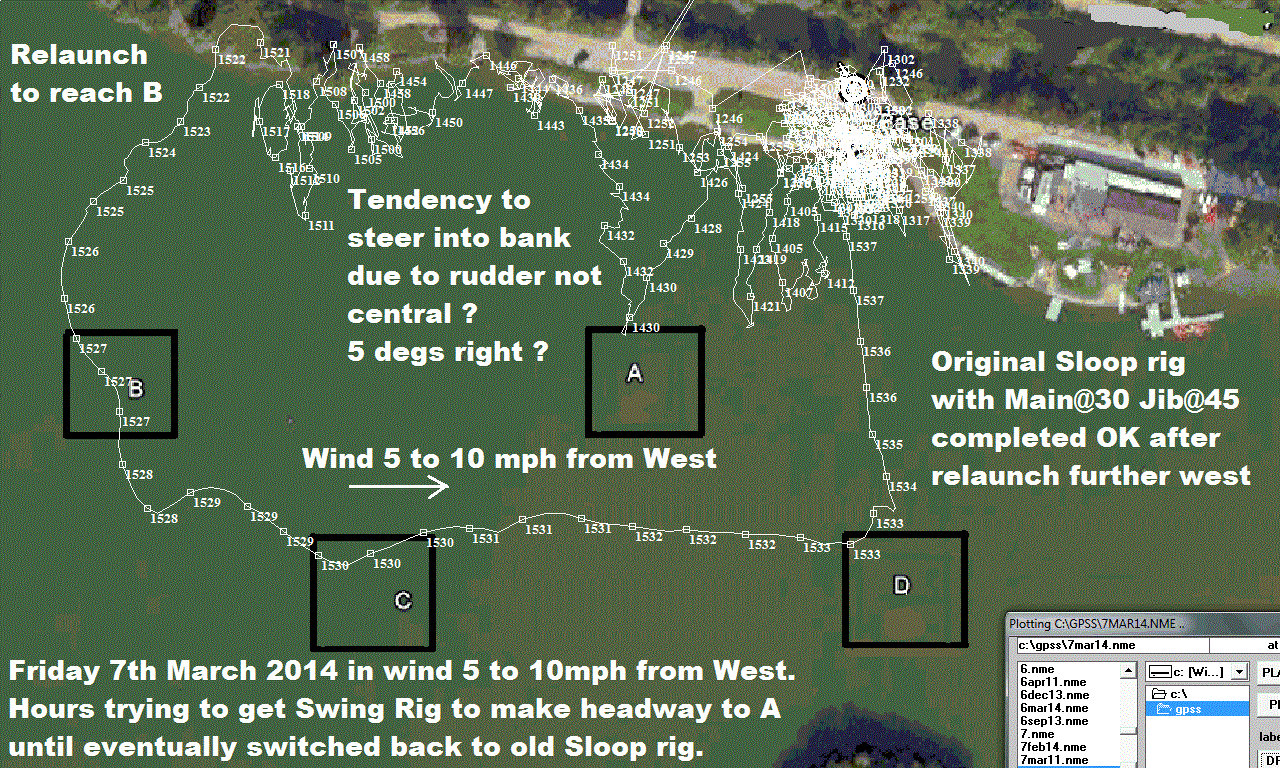 Saturday 8th March: Click on the GPS plot on the left to see the details of yesterday's sailing tests.
In summary: we spent hours trying to get the swing rig to work, but failed to get away upwind, to the first waypoint.
This was after trying the jib pulled in at 10, and let out at 45. Also we tried further reduction of rudder gearing
to the 3rd hole (10mm/28=0.36=max 16 degrees). The boom seemed to swing in the correct direction, but only just,
and the jib rarely seemed to be doing any work. The boat had the usual tendency to tack into the north bank, and
to "steer left" when going out to waypoint B. At home, a more accurate check
on the rudder centre position showed a slight (5 degree?) bias to the right. This was for all three gearing positions.
This has been corrected, and we hope to get better "tacking" behaviour with both swing rig and original sloop rig.
Saturday 8th March: Click on the GPS plot on the left to see the details of yesterday's sailing tests.
In summary: we spent hours trying to get the swing rig to work, but failed to get away upwind, to the first waypoint.
This was after trying the jib pulled in at 10, and let out at 45. Also we tried further reduction of rudder gearing
to the 3rd hole (10mm/28=0.36=max 16 degrees). The boom seemed to swing in the correct direction, but only just,
and the jib rarely seemed to be doing any work. The boat had the usual tendency to tack into the north bank, and
to "steer left" when going out to waypoint B. At home, a more accurate check
on the rudder centre position showed a slight (5 degree?) bias to the right. This was for all three gearing positions.
This has been corrected, and we hope to get better "tacking" behaviour with both swing rig and original sloop rig.
 We may also be luckier with the wind, and get more useful tests results more quickly.
The rudder gearing is back to the 2nd servo hole. i.e. 0.46=21 degrees max.
The picture on the right shows the solar lamps under test in my front garden, watched by CCTV. The new "6. ultra"
on the right looks promising. It seems a good compromise between brightness vs simplicity, weight (150gm) and cost (£10).
We may also be luckier with the wind, and get more useful tests results more quickly.
The rudder gearing is back to the 2nd servo hole. i.e. 0.46=21 degrees max.
The picture on the right shows the solar lamps under test in my front garden, watched by CCTV. The new "6. ultra"
on the right looks promising. It seems a good compromise between brightness vs simplicity, weight (150gm) and cost (£10).
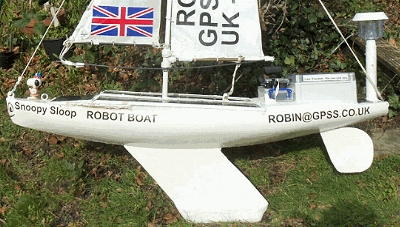 It seems to run all night, if the single AAA 400mAH battery is replaced by a better one. e.g. 600mAH.
It has a fresnel lens and reflector, to give better beam directions from the four LED pointing down.
On the left is the boat, after re-assembly of a swing rig, but with smaller 5mm diameter carbon-fibre tube,
bent to hold the jib in place, set close to the mast, providing a small 20mm "slot" to the mainsail.
Next test sail should be early this coming week, and
expected winds
look good, from the north east, so we should get out to the first waypoint quickly, and start a more useful
test to see if the swing rig helps.
It seems to run all night, if the single AAA 400mAH battery is replaced by a better one. e.g. 600mAH.
It has a fresnel lens and reflector, to give better beam directions from the four LED pointing down.
On the left is the boat, after re-assembly of a swing rig, but with smaller 5mm diameter carbon-fibre tube,
bent to hold the jib in place, set close to the mast, providing a small 20mm "slot" to the mainsail.
Next test sail should be early this coming week, and
expected winds
look good, from the north east, so we should get out to the first waypoint quickly, and start a more useful
test to see if the swing rig helps.
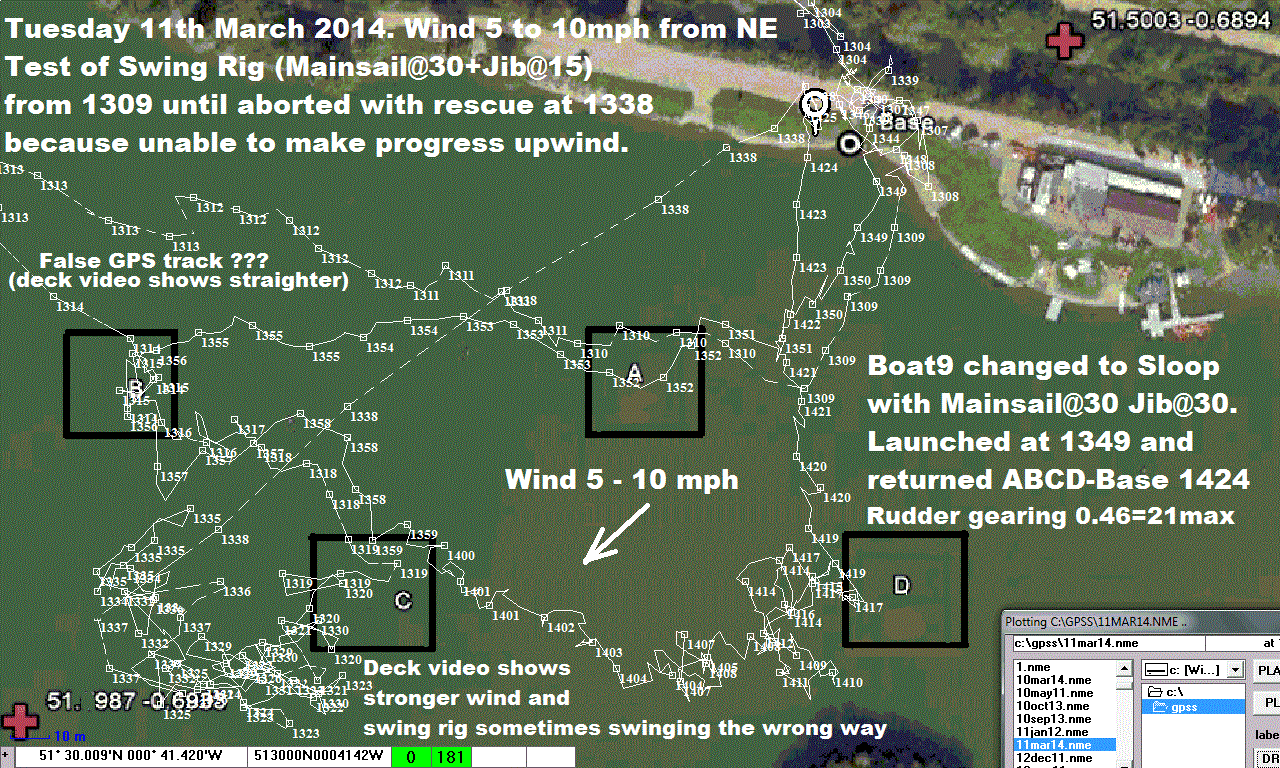 Tuesday 11th March: the GPS plots on the right show results of today's sailing tests, with a swing rig, and then
the conventional sloop rig. Click on it to see the details. We have a lot of video to analyse, including from shore based cameras and the Mobius deck camera.
However, it seems we will reach the conclusion that we cannot do better than use our old "sloop rig", with the mainsail
set at 30 degrees and the jib also 30, or similar. It seems the steering is sensitive to any errors in rudder
central position, and we need to continue testing in a variety of wind strengths and directions.
The next sail will be with the same sail settings, but with the rudder gearing increased from today's
0.46=21 degrees max, back to 0.57=26 degrees max.
The swing rig will probably be consigned to the junk box for now :-)
Tuesday 11th March: the GPS plots on the right show results of today's sailing tests, with a swing rig, and then
the conventional sloop rig. Click on it to see the details. We have a lot of video to analyse, including from shore based cameras and the Mobius deck camera.
However, it seems we will reach the conclusion that we cannot do better than use our old "sloop rig", with the mainsail
set at 30 degrees and the jib also 30, or similar. It seems the steering is sensitive to any errors in rudder
central position, and we need to continue testing in a variety of wind strengths and directions.
The next sail will be with the same sail settings, but with the rudder gearing increased from today's
0.46=21 degrees max, back to 0.57=26 degrees max.
The swing rig will probably be consigned to the junk box for now :-)
 Monday 24th March: a good sail today, after a long gap due to lack of wind, and attending to work in the garden such as
a new bridge and repairs to the pond. Click on the GPS plot on the left to see the details: it seems that the zig-zag sailing
might be sensitive to the gearing of the rudder. The only change today was increase of rudder gearing to 26 degrees max.
While waiting for suitable wind, I've been making a new mast and main boom, to complete a new rig with the new sails
from Frank at Nylet.
Monday 24th March: a good sail today, after a long gap due to lack of wind, and attending to work in the garden such as
a new bridge and repairs to the pond. Click on the GPS plot on the left to see the details: it seems that the zig-zag sailing
might be sensitive to the gearing of the rudder. The only change today was increase of rudder gearing to 26 degrees max.
While waiting for suitable wind, I've been making a new mast and main boom, to complete a new rig with the new sails
from Frank at Nylet.
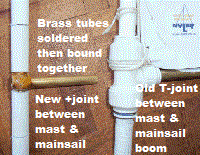 On the right is the new and old "T-joint" between mast and mainsail boom. The old one used
some plastic plumbing, and the new "+joint" is based on two pieces of brass tube at right-angles. This is a neater
solution, and permits easier switching to a swing-rig, if we try that again. The mast uses the same construction
approach, the core being 10mm carbon fibre rod, surrounded by brass tubes then plastic pipe.
Today was promising because we got a fast,
straight and accurate return downwind. Testing will continue, to try and find the optimum trim of sails and rudder.
These old sails never did look "nicely formed", due to the extra layer of plastic added. Maybe the new sails will help,
when we get around to fitting them.
On the right is the new and old "T-joint" between mast and mainsail boom. The old one used
some plastic plumbing, and the new "+joint" is based on two pieces of brass tube at right-angles. This is a neater
solution, and permits easier switching to a swing-rig, if we try that again. The mast uses the same construction
approach, the core being 10mm carbon fibre rod, surrounded by brass tubes then plastic pipe.
Today was promising because we got a fast,
straight and accurate return downwind. Testing will continue, to try and find the optimum trim of sails and rudder.
These old sails never did look "nicely formed", due to the extra layer of plastic added. Maybe the new sails will help,
when we get around to fitting them.
 Wednesday 26th March: the new rig, including sails, has been fitted, ready for the next sailing test.
See picture on the left. Both mainsail and jib
are tied in the corners only. Lacing, using the eyelets, will be done after we see any effect of sail forms
on sailing behaviour.
We have also moved the box holding the Mio P350 Pocket PC, used to record the GPS track, further forward.
This is hoped to reduce the "scatter" of GPS positions in above GPS plots. The Mobius video camera
remains where it was, so we can observe the action of both sails. Note that FM transmitter, Mobius camera,
and Pocket PC, are only used during tests on Bray Lake, and removed before launch at sea.
Wednesday 26th March: the new rig, including sails, has been fitted, ready for the next sailing test.
See picture on the left. Both mainsail and jib
are tied in the corners only. Lacing, using the eyelets, will be done after we see any effect of sail forms
on sailing behaviour.
We have also moved the box holding the Mio P350 Pocket PC, used to record the GPS track, further forward.
This is hoped to reduce the "scatter" of GPS positions in above GPS plots. The Mobius video camera
remains where it was, so we can observe the action of both sails. Note that FM transmitter, Mobius camera,
and Pocket PC, are only used during tests on Bray Lake, and removed before launch at sea.
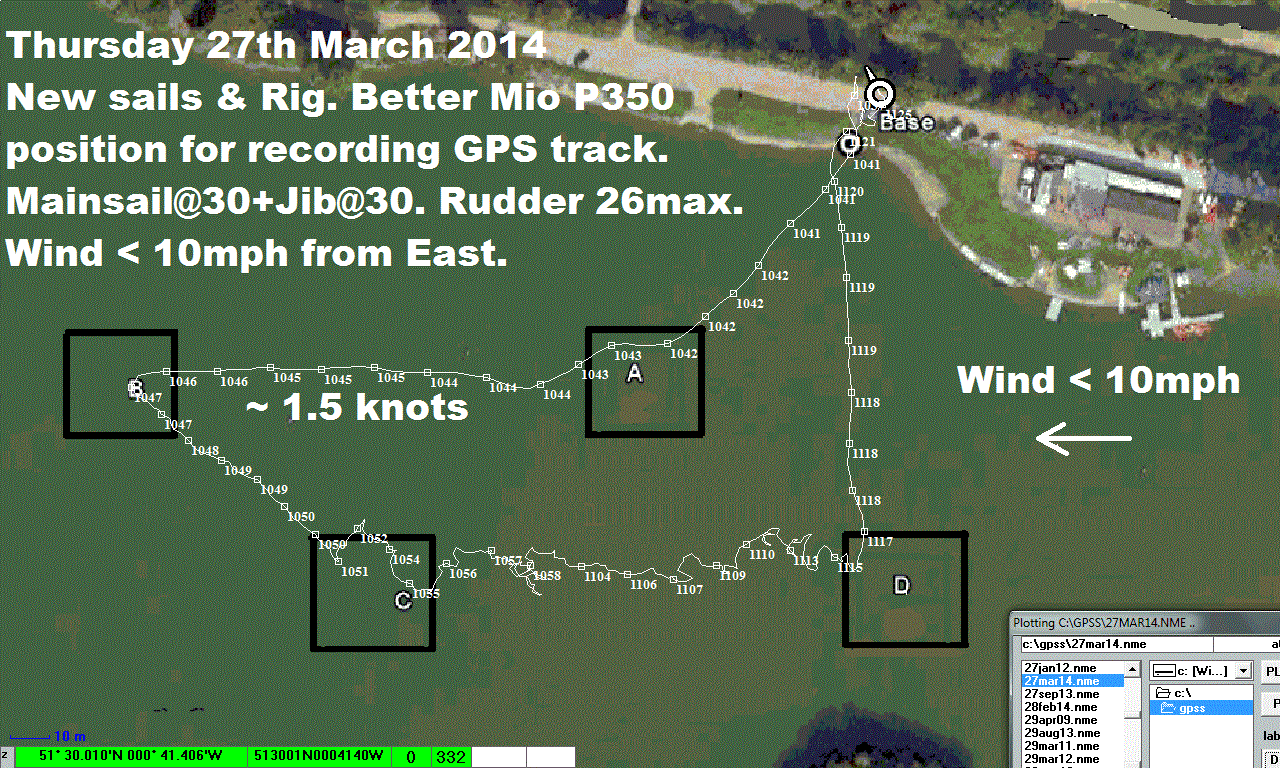 Thursday 27th March: an excellent sail today, with no zig-zag visible, down-wind or cross-wind. Much of the staighter
path, shown in the GPS plot on the right, was almost certainly due to the better position of the Mio P350 Pocket PC,
that collects the GPS data to provide the plot. Click on the picture to see more detail.
Thursday 27th March: an excellent sail today, with no zig-zag visible, down-wind or cross-wind. Much of the staighter
path, shown in the GPS plot on the right, was almost certainly due to the better position of the Mio P350 Pocket PC,
that collects the GPS data to provide the plot. Click on the picture to see more detail.
 On the left is the boat, with new sails, on it's way out to the first waypoint. You may just
see the neater, curved, sail shape, compared with the old sails, of identical cut shape.
These more flexible sails do tend to flutter more, when close to the wind, but may account
for some of the improved sailing. They need to be laced, to give strength, and we will take
account of the shape you see here. i.e. not pulled right in to the mast towards the middle.
We will swap the "soft glow" lamp seen here, for the "ultra bright" product, probably
on a slightly lower lamp post. The boat may then be getting close to what will be better
than boat9 used for the 2013 attempt. There are sufficient changes, such as the keel and rudder,
for us to call it "Boat 10" :-)
On the left is the boat, with new sails, on it's way out to the first waypoint. You may just
see the neater, curved, sail shape, compared with the old sails, of identical cut shape.
These more flexible sails do tend to flutter more, when close to the wind, but may account
for some of the improved sailing. They need to be laced, to give strength, and we will take
account of the shape you see here. i.e. not pulled right in to the mast towards the middle.
We will swap the "soft glow" lamp seen here, for the "ultra bright" product, probably
on a slightly lower lamp post. The boat may then be getting close to what will be better
than boat9 used for the 2013 attempt. There are sufficient changes, such as the keel and rudder,
for us to call it "Boat 10" :-)
 Click on the GPS plot on the right, to read the detail, but in summary: it sailed much as before,
but with weather helm (turning towards wind), due to the stronger wind - and probably not helped by
the high "lunchbox" and "lamp post" at the back. As expected, the only slow part of the route was
when the boat was returning B-C-D against the wind.
Click on the GPS plot on the right, to read the detail, but in summary: it sailed much as before,
but with weather helm (turning towards wind), due to the stronger wind - and probably not helped by
the high "lunchbox" and "lamp post" at the back. As expected, the only slow part of the route was
when the boat was returning B-C-D against the wind.
 Sunday 30th March: the mast has been moved forward again, by about 11cm/4.5", to try and reduce the
weather helm, and achieve a straighter sailing path. This blog shows that the last time this was tried
was 9th January, and since then, significant changes and corrections have been made to things like
the rudder. The mainsail boom is still 13cm above the deck, and the jib now fastens to the eye
at the very front, instead of behind Snoopy. Tests will continue to see if we can improve
the sailing even more.
Sunday 30th March: the mast has been moved forward again, by about 11cm/4.5", to try and reduce the
weather helm, and achieve a straighter sailing path. This blog shows that the last time this was tried
was 9th January, and since then, significant changes and corrections have been made to things like
the rudder. The mainsail boom is still 13cm above the deck, and the jib now fastens to the eye
at the very front, instead of behind Snoopy. Tests will continue to see if we can improve
the sailing even more.
 Wednesday 2nd April: Click on the GPS plot on the right, to see details of today's test with
the mast moved forward 11cm, and in an East wind of about 10mph. The result was OK, but we need
to test in a stronger wind to confirm we have reduced weather helm. The computer speech on the video
indicated a tendency to make corrections to the right, and a small error in rudder centre position
could just be seen at home. Two turns of the linkage have been applied, to see if this helps.
The downwind speed of about 2 knots in a 10mph wind was promising.
Wednesday 2nd April: Click on the GPS plot on the right, to see details of today's test with
the mast moved forward 11cm, and in an East wind of about 10mph. The result was OK, but we need
to test in a stronger wind to confirm we have reduced weather helm. The computer speech on the video
indicated a tendency to make corrections to the right, and a small error in rudder centre position
could just be seen at home. Two turns of the linkage have been applied, to see if this helps.
The downwind speed of about 2 knots in a 10mph wind was promising.
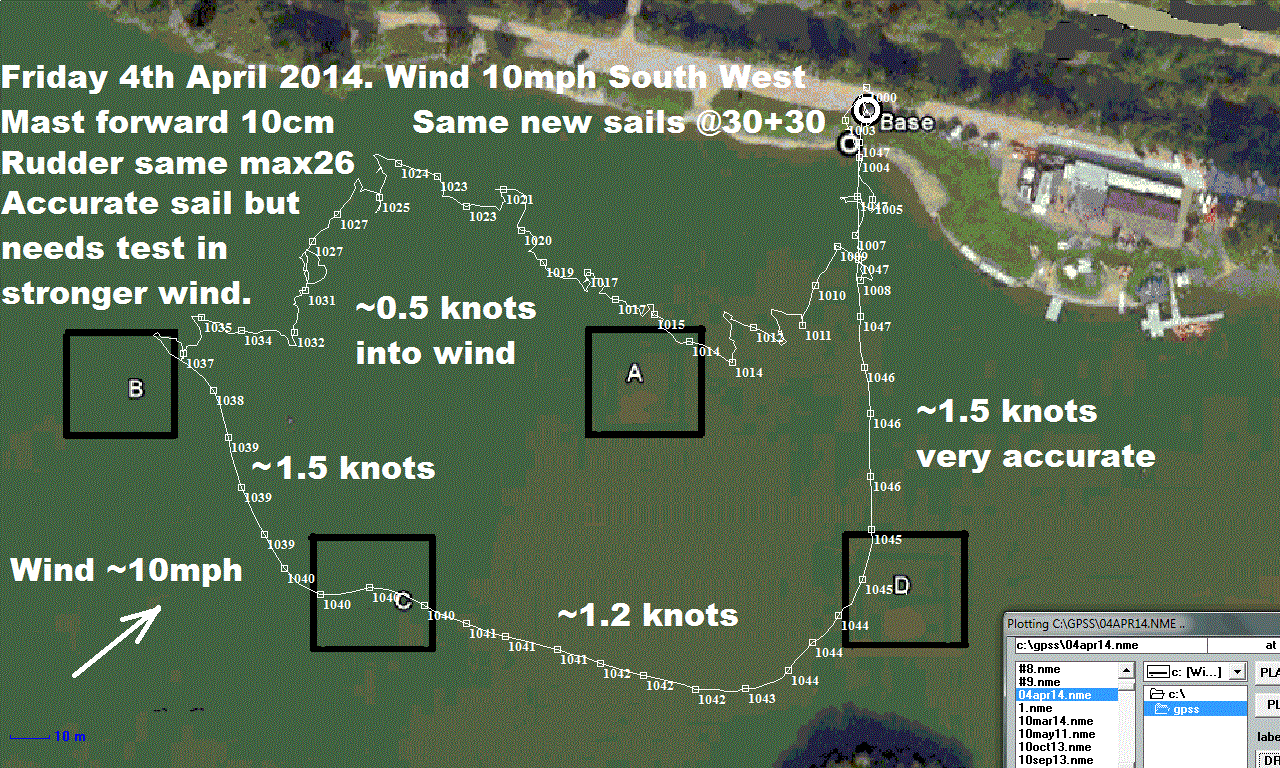 Friday 4th April: another good sail, in wind of about 10mph, straighter than ever, but we are still waiting for stronger wind,
of at least 15mph, to confirm we have fixed the zig-zag sailing. Click on the GPS plot on the left to read the details.
Our best guess at present is that the zig-zag sailing downwind was due to a number of factors,
including "balance" of the boat (e.g. mast position, keel and rudder), and small adjustment errors,
such as the rudder not being perfectly central.
Friday 4th April: another good sail, in wind of about 10mph, straighter than ever, but we are still waiting for stronger wind,
of at least 15mph, to confirm we have fixed the zig-zag sailing. Click on the GPS plot on the left to read the details.
Our best guess at present is that the zig-zag sailing downwind was due to a number of factors,
including "balance" of the boat (e.g. mast position, keel and rudder), and small adjustment errors,
such as the rudder not being perfectly central.
 Tuesday 8th April: Click on the GPS plot on the right to see the details. Today we had a good strong wind
from the West, of about 15 mph, probably gusting to nearly 30. The wind strength increased
as Snoopy got within 30 metres of waypoint B, and this seems why he was blown back, to hit waypoint C by accident.
But then we got the test we needed - sailing directly downwind in a strong wind. Sadly, the zig-zag reappeared,
so we are not finished trying to reduce it. The good news is that Snoopy is performing better than before,
with his return, cross-wind to Base, at about 2.6 knots ! Earlier today, we recharged batteries, because we
noticed they were low, and the SPOT tracker had stopped. This was due to recent days being indoors, away from the sun.
Work continues to straighten the sailing behaviour - minor adjustments and some lateral thinking needed ? :-)
Tuesday 8th April: Click on the GPS plot on the right to see the details. Today we had a good strong wind
from the West, of about 15 mph, probably gusting to nearly 30. The wind strength increased
as Snoopy got within 30 metres of waypoint B, and this seems why he was blown back, to hit waypoint C by accident.
But then we got the test we needed - sailing directly downwind in a strong wind. Sadly, the zig-zag reappeared,
so we are not finished trying to reduce it. The good news is that Snoopy is performing better than before,
with his return, cross-wind to Base, at about 2.6 knots ! Earlier today, we recharged batteries, because we
noticed they were low, and the SPOT tracker had stopped. This was due to recent days being indoors, away from the sun.
Work continues to straighten the sailing behaviour - minor adjustments and some lateral thinking needed ? :-)
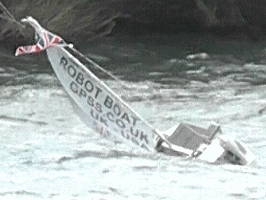
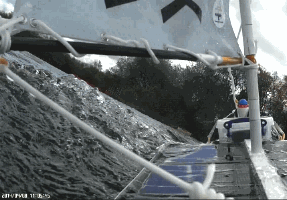 You can play it by watching
Snoopy's Zig-Zag Sailing Test Video.
The pictures to left and right are at about 1145 GMT + 40 seconds.
i.e. before Snoopy turned sharply to the left, to enter the waypoint box D, near the island.
The timestamp in the low-left corner of the Mobius deck video is close to being GPS time in the GPS plot.
Tests today, against a radio clock, showed that the deck camera time yesterday was about 7 seconds fast.
The camera gains about 4 seconds per day, but was last reset last Thursday. These times are GMT (Universal Time)
and so one hour different from BST on my wrist watch.
You can play it by watching
Snoopy's Zig-Zag Sailing Test Video.
The pictures to left and right are at about 1145 GMT + 40 seconds.
i.e. before Snoopy turned sharply to the left, to enter the waypoint box D, near the island.
The timestamp in the low-left corner of the Mobius deck video is close to being GPS time in the GPS plot.
Tests today, against a radio clock, showed that the deck camera time yesterday was about 7 seconds fast.
The camera gains about 4 seconds per day, but was last reset last Thursday. These times are GMT (Universal Time)
and so one hour different from BST on my wrist watch.
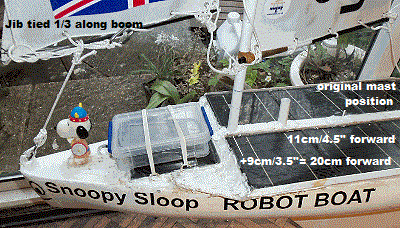 The strings were adjusted to keep the sails at
the same 30 degree swing from centre. That on the jib needed to be tied onto it's boom, about 1/3 from the front.
We will see if this reduces that weather helm, and gives a straighter sailing path.
Now we need a decent wind for test !
The strings were adjusted to keep the sails at
the same 30 degree swing from centre. That on the jib needed to be tied onto it's boom, about 1/3 from the front.
We will see if this reduces that weather helm, and gives a straighter sailing path.
Now we need a decent wind for test !
 Saturday 12th April: Click on the GPS Plot on the right to see details of today's useful test. Moving the mast forward that extra
9cm/3.5" was clearly too much: we now have "Lee Helm" instead of "Weather Helm". i.e. the boat tends to turn downwind
- so much that it failed to reach waypoint A, and the full right rudder slowed the boat to about 0.8 knots.
When it reached the island, and less wind due to the trees, it managed to turn, and started coming back, now trying to turn left
to A. But then it hit waypoint D by accident, which told it to return to Base. This did not need much rudder, and this cross-wind
return was nice and fast, at about 2 knots.
Saturday 12th April: Click on the GPS Plot on the right to see details of today's useful test. Moving the mast forward that extra
9cm/3.5" was clearly too much: we now have "Lee Helm" instead of "Weather Helm". i.e. the boat tends to turn downwind
- so much that it failed to reach waypoint A, and the full right rudder slowed the boat to about 0.8 knots.
When it reached the island, and less wind due to the trees, it managed to turn, and started coming back, now trying to turn left
to A. But then it hit waypoint D by accident, which told it to return to Base. This did not need much rudder, and this cross-wind
return was nice and fast, at about 2 knots.
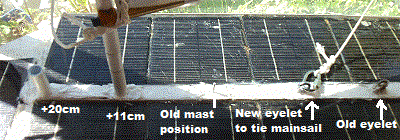 Sunday 13th April:
We have returned the mast position and sails to what they were earlier.
However, we now have an extra eyelet, to tie the mainsail to the deck, about 10cm/4" forward of the old position.
We may expect that this will also reduce weather helm, since the force from the sails is carried to the boat by
the mast, and by the two places the sails are tied to the deck. This is an alternative to trying the mast
in a position between the two forward positions.
We will see the effect when the wind is strong enough again.
Sunday 13th April:
We have returned the mast position and sails to what they were earlier.
However, we now have an extra eyelet, to tie the mainsail to the deck, about 10cm/4" forward of the old position.
We may expect that this will also reduce weather helm, since the force from the sails is carried to the boat by
the mast, and by the two places the sails are tied to the deck. This is an alternative to trying the mast
in a position between the two forward positions.
We will see the effect when the wind is strong enough again.
 Tuesday 15th April: Two very good sails yesterday, with Snoopy completing both circuits in less than 30 minutes !
The good times were expected because wind from the North-East means that the boat does not need to spend
a long time, on one of the legs, sailing directly into the wind. This happened occasionally, due to shifting
wind direction, and one or twice the wind dropped to less than 5 mph.
Click on the GPS plot on the right to see the details.
Little difference could be seen between
the two tracks, the first being with the mainsail tied to the new, forward position, and the second
being at the old position. All other things were the same. i.e. mast at it's 11cm forward position,
both sails set to swing 30 degrees from centre, and rudder gearing at 26 degrees maximum.
We need to test in a stronger wind.
Tuesday 15th April: Two very good sails yesterday, with Snoopy completing both circuits in less than 30 minutes !
The good times were expected because wind from the North-East means that the boat does not need to spend
a long time, on one of the legs, sailing directly into the wind. This happened occasionally, due to shifting
wind direction, and one or twice the wind dropped to less than 5 mph.
Click on the GPS plot on the right to see the details.
Little difference could be seen between
the two tracks, the first being with the mainsail tied to the new, forward position, and the second
being at the old position. All other things were the same. i.e. mast at it's 11cm forward position,
both sails set to swing 30 degrees from centre, and rudder gearing at 26 degrees maximum.
We need to test in a stronger wind.
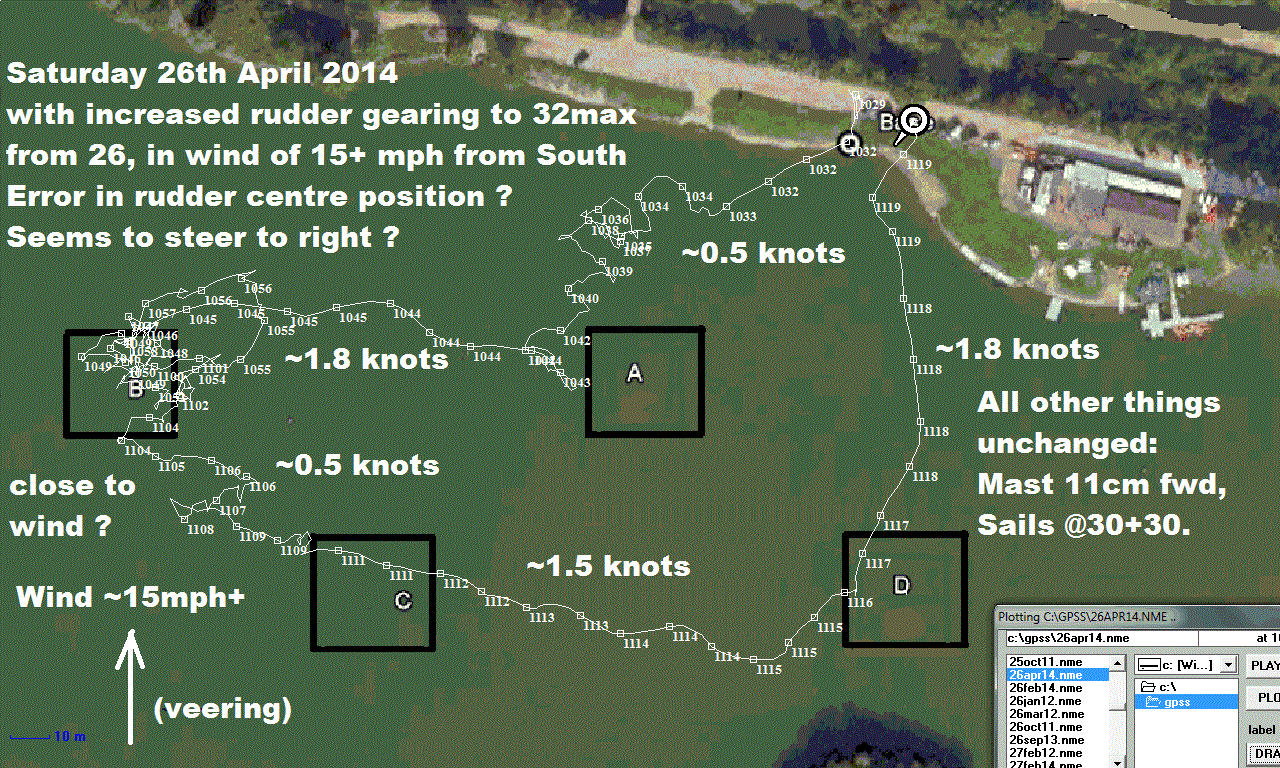 Wednesday 16th April: The mainsail tie has been returned to it's new, forward position, and the rudder
gearing increased from 26 to 32 degrees max. i.e. the servo linkage moved in one hole on the rudder arm,
following notes of 26th February above. Tests indoors, with a 80cm stick fixed to the rudder with pegs,
were used to ensure rudder was same central position as before. This also indicated bigger rudder
maximums than those based on lever hole positions. e.g. 26 to 34 and 32 to 57. This not important
while the steering linkage remains the same. The mast position (11cm forward) and sail settings (30+30)
remain the same.
The boat is ready for it's next test - hopefully in a strong wind!
Wednesday 16th April: The mainsail tie has been returned to it's new, forward position, and the rudder
gearing increased from 26 to 32 degrees max. i.e. the servo linkage moved in one hole on the rudder arm,
following notes of 26th February above. Tests indoors, with a 80cm stick fixed to the rudder with pegs,
were used to ensure rudder was same central position as before. This also indicated bigger rudder
maximums than those based on lever hole positions. e.g. 26 to 34 and 32 to 57. This not important
while the steering linkage remains the same. The mast position (11cm forward) and sail settings (30+30)
remain the same.
The boat is ready for it's next test - hopefully in a strong wind!
 Saturday 10th May: Click on yesterday's GPS Plot are on the right, to see the details. The strong wind meant
that there was no progress upwind, and re-launches were needed to reach upwind waypoints A then B. Finally,
Snoopy hit waypoint B and completed the trip averaging over two knots, but with zig-zag seen when downwind.
The centred rudder seemed to give more balanced sailing, in all directions relative to wind.
The Mio Pocket PC was protected by a plastic sandwich bag around it's box. The Mobius deck camera lasted 67 minutes,
which was not enough to catch the final trip. Conclusion is that the increased rudder gearing may not have
improved the sailing. It's possible it made progress upwind worse. Less rudder would delay turning into wind,
and rely on the autopilot automatic trim to increase the time sailing close to the wind.
The rudder has been returned to it's earlier setting of 26max - and carefully centered.
The boat is ready for the next test, and it seems we may be close to getting it as good as we can.
Saturday 10th May: Click on yesterday's GPS Plot are on the right, to see the details. The strong wind meant
that there was no progress upwind, and re-launches were needed to reach upwind waypoints A then B. Finally,
Snoopy hit waypoint B and completed the trip averaging over two knots, but with zig-zag seen when downwind.
The centred rudder seemed to give more balanced sailing, in all directions relative to wind.
The Mio Pocket PC was protected by a plastic sandwich bag around it's box. The Mobius deck camera lasted 67 minutes,
which was not enough to catch the final trip. Conclusion is that the increased rudder gearing may not have
improved the sailing. It's possible it made progress upwind worse. Less rudder would delay turning into wind,
and rely on the autopilot automatic trim to increase the time sailing close to the wind.
The rudder has been returned to it's earlier setting of 26max - and carefully centered.
The boat is ready for the next test, and it seems we may be close to getting it as good as we can.
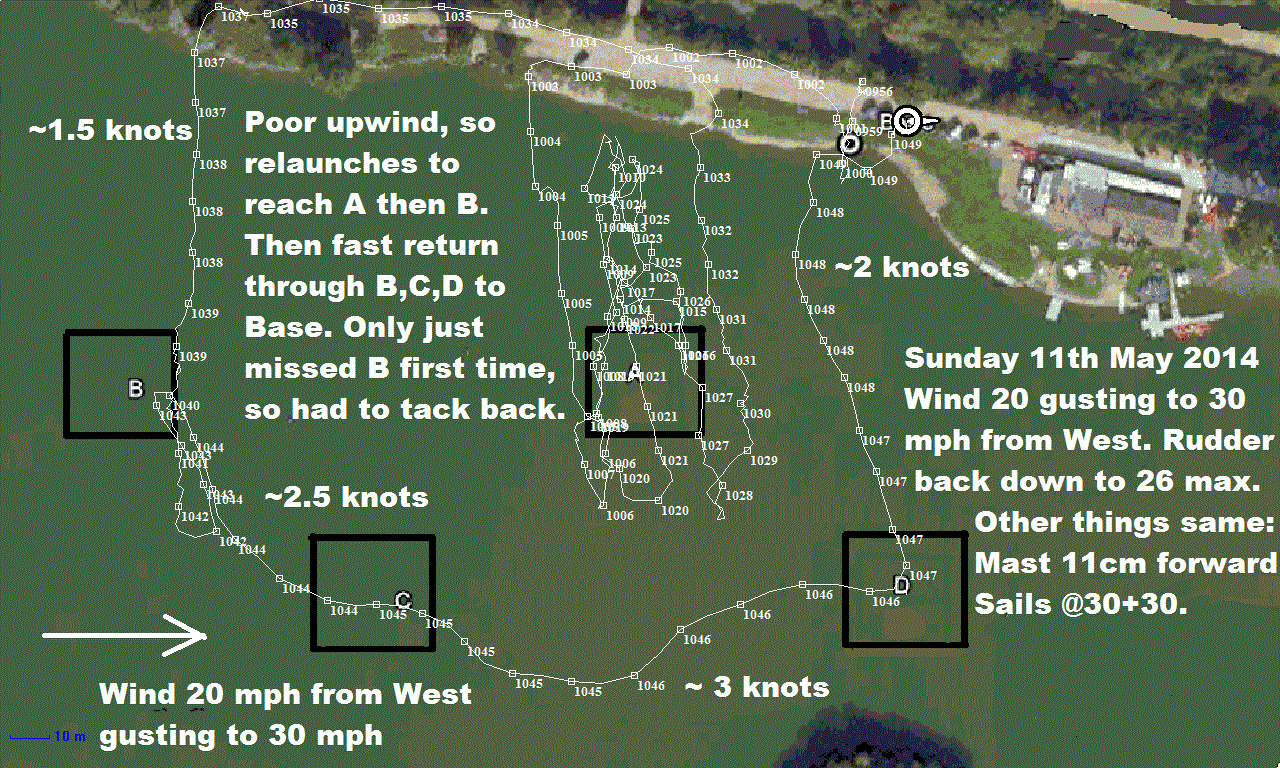 Sunday 11th May: Click on the GPS plot on the left to see the details. Today's sail, in practically identical conditions of a strong West wind, confirmed that
the boat is probably as good as we can adjust it. i.e. the optimum settings seem to be with the rudder
gearing at 26 degrees max, and the mast at it's 11cm forward position. We now know how important the rudder centre position is
to the boat performing well. With these settings, the boat seems to sail reasonably straight in most directions.
It will not make progress directly upwind, if the wind exceeds about 20mph, but we can probably live with that.
Sunday 11th May: Click on the GPS plot on the left to see the details. Today's sail, in practically identical conditions of a strong West wind, confirmed that
the boat is probably as good as we can adjust it. i.e. the optimum settings seem to be with the rudder
gearing at 26 degrees max, and the mast at it's 11cm forward position. We now know how important the rudder centre position is
to the boat performing well. With these settings, the boat seems to sail reasonably straight in most directions.
It will not make progress directly upwind, if the wind exceeds about 20mph, but we can probably live with that.
 Today we were luckier with earlier landings and re-launches, so the Mobius deck camera caught the whole mission.
This included some nice close-approaches to other Bray Lake users ! :-)
We will now proceed to 24/7 reliability testing, after a tidy up of the lacing of the sails with thinner string.
We will also repeat the Bray Lake Test, in a variety of wind conditions, to confirm the boat is ready for an Atlantic attempt.
Today we were luckier with earlier landings and re-launches, so the Mobius deck camera caught the whole mission.
This included some nice close-approaches to other Bray Lake users ! :-)
We will now proceed to 24/7 reliability testing, after a tidy up of the lacing of the sails with thinner string.
We will also repeat the Bray Lake Test, in a variety of wind conditions, to confirm the boat is ready for an Atlantic attempt.
 Friday 16th May: 24/7 tests on Bray Lake started. Click on the SPOT map on left to see latest.
Friday 16th May: 24/7 tests on Bray Lake started. Click on the SPOT map on left to see latest.
Monday 19th May: pushed out from bank at 10am, after wandering 11pm to 2am in little wind. Earlier nights OK in less than 2mph wind.
Friday 23rd May: Snoopy has completed first week of 24/7 testing without problems.
Monday 26th May: wind dropped to 2mph, so Snoopy drifted to north bank by 1008pm. Sailed back out before 0909, after wind rose from north.
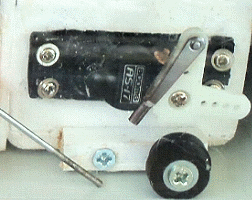
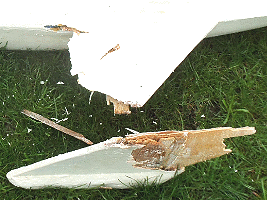 Wednesday 28th May: Snoopy at home and major repairs needed, including mending the broken keel ! Snoopy drifted in to the south bank
before 0809 this morning, despite wind of more than 7mph all night. After rescue at about 1010am, the main 5v power system had gone
flat, within the few hours of having been fully charged. 2.8v,2.75v->2.7v. Also, the rudder servo clevis had come off it's push rod.
It seems the threads were never matched! New (matched) clevis and rods were purchased on way home. The most serious problem was
the broken keel - seen to be cracked and moving when the boat was put into the car. It was checked when we got home and found
to be falling apart: water had been creeping into the plywood over the past 18 months - including those hours at sea - and only
the fastglass skin was holding it together.
Wednesday 28th May: Snoopy at home and major repairs needed, including mending the broken keel ! Snoopy drifted in to the south bank
before 0809 this morning, despite wind of more than 7mph all night. After rescue at about 1010am, the main 5v power system had gone
flat, within the few hours of having been fully charged. 2.8v,2.75v->2.7v. Also, the rudder servo clevis had come off it's push rod.
It seems the threads were never matched! New (matched) clevis and rods were purchased on way home. The most serious problem was
the broken keel - seen to be cracked and moving when the boat was put into the car. It was checked when we got home and found
to be falling apart: water had been creeping into the plywood over the past 18 months - including those hours at sea - and only
the fastglass skin was holding it together.

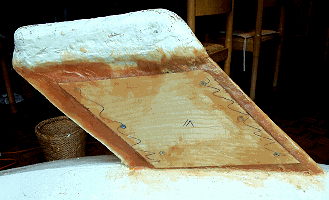 Thursday 29th May: Today the keel was fixed, and has now been painted. The keel is the same profile,
but thicker, at about 20mm (0.8") instead of the original 10mm. Two pieces of good quality 5mm plywood were covered with
fast-glass resin, each with a sheet of fibreglass sandwiched underneath, and six self-tapping screws for good measure.
Isopon P40 fibreglass filler was used to blend in the edges, including keel leading and trailing edges.
Most SPOT transmissions get through, despite the boat often being upside-down, due to some kitchen foil on the floor :-)
It is possible that the slipping
servo clevis was the root cause of problems like the rudder moving off-centre, and maybe even his hitting the south bank.
We will know after a few days of 24/7 testing at Bray Lake, expected to start again tomorrow.
Thursday 29th May: Today the keel was fixed, and has now been painted. The keel is the same profile,
but thicker, at about 20mm (0.8") instead of the original 10mm. Two pieces of good quality 5mm plywood were covered with
fast-glass resin, each with a sheet of fibreglass sandwiched underneath, and six self-tapping screws for good measure.
Isopon P40 fibreglass filler was used to blend in the edges, including keel leading and trailing edges.
Most SPOT transmissions get through, despite the boat often being upside-down, due to some kitchen foil on the floor :-)
It is possible that the slipping
servo clevis was the root cause of problems like the rudder moving off-centre, and maybe even his hitting the south bank.
We will know after a few days of 24/7 testing at Bray Lake, expected to start again tomorrow.
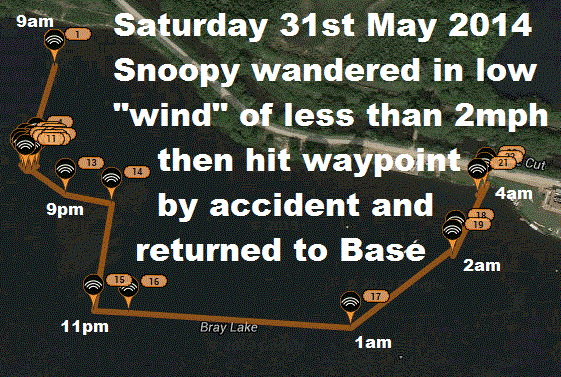
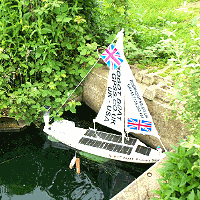 Saturday 31st May: click on the SPOT map snapshot on the left to see the details. Snoopy started to wander, as one would expect,
by 9pm Friday, when the "wind" from the north-east had dropped to below 2 mph. When visited before 9am today, he was found "parked"
exactly on his Base position, in the drain inlet (see right). His autopilot was still running, operating the rudder, and a power
check showed plenty of power in the duplicated 5v supply (4.81v,4.87v->4.62v). This means he will have hit a waypoint,
perhaps B, then completed his normal test through C and D near the island, and back to Base. This was a remarkable
feat in such light wind conditions. He was put back in Snoopy Corner at 9am, and we can expect him to wander again
because of the very light wind conditions. Hopefully the sun will come out to create some thermals, and also
charge up his batteries.
Saturday 31st May: click on the SPOT map snapshot on the left to see the details. Snoopy started to wander, as one would expect,
by 9pm Friday, when the "wind" from the north-east had dropped to below 2 mph. When visited before 9am today, he was found "parked"
exactly on his Base position, in the drain inlet (see right). His autopilot was still running, operating the rudder, and a power
check showed plenty of power in the duplicated 5v supply (4.81v,4.87v->4.62v). This means he will have hit a waypoint,
perhaps B, then completed his normal test through C and D near the island, and back to Base. This was a remarkable
feat in such light wind conditions. He was put back in Snoopy Corner at 9am, and we can expect him to wander again
because of the very light wind conditions. Hopefully the sun will come out to create some thermals, and also
charge up his batteries.
1330 update: Needed Clubhouse boat to reach spot on west bank where he landed by 1107: out again at 1230. Some sun and thermals now.
For latest position of Snoopy, see the
Live SPOT 24 hour Map.
Sunday 1st June: Snoopy holding 24/7 station well, despite drifting to near north bank at midnight, in wind less than 2mph. Sunny.
2230 update: Starting drifting in low wind (~2mph) by 906pm and hit Base by 1006pm. He can stay parked there again tonight :-)
Monday 2nd June: relaunched at 9am after checking power - fully charged (5.38v,5.43v->5.17v) and autopilot still running: looks good.
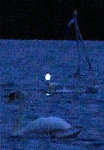 Took video of navigation light coming on at dusk, at 9:40pm, about 30 minutes after sunset.
Took video of navigation light coming on at dusk, at 9:40pm, about 30 minutes after sunset.
Tuesday 3rd June: Snoopy came to the north shore of Snoopy Corner before 0205am. Checked just after 10am, in wet and cloudy
conditions, and autopilot was still operating OK. Main 5v power was good (5.13v,5.09v->4.87v) so it seems Snoopy beached
due to the usual cause of wind below 2 or 3 mph. However, the
Met Office local winds
said the wind had been more than 5mph all night. We need to check the accuracy of this web site, next time we see dead calm
during the day. The sun is starting to come out, this afternoon, so that should keep batteries topped up :-)
Wednesday 4th June: near 24/7 waypoint, despite wandering near north bank, in very light wind, after 10pm until after 5am. Rain, cloud,
and bright spots today.
1130 update: saw Snoopy at Clubhouse on the
Live SPOT Map.
Due to my 'phone call earlier - they thought he needed a rescue. Will put him back later today :-)
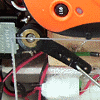 1530 update: relaunched onto 24/7 test, after useful checks, as a diversion prior to a Pub Lunch with my "Last of the Summer Wine" Team.
The boat was waiting for me, as expected, laid on one of the outside tables at the Bray Lake Clubhouse. The autopilot was still running,
but I was surprised to see the rudder off-centre. The rudder post lever could turn on it's rudder post, despite the grub screw,
clamping it to a flat filed on the steel rod. I didn't have the required Allen Key with me, to check if the screw had come loose,
then tighten it. We must check this simple but critical thing at our next opportunity. We relaunched at about 1pm, after pushing
the rudder central, and I see it has already held 24/7 station for over two hours: we will see when it next comes ashore.
The sun had fully charged the main 5v power (5.5v,5.5v->5.27v), and wind is not expected to drop, so - if Snoopy comes ashore soon
- it will probably be due to that rudder lever needing to be tightened !
1530 update: relaunched onto 24/7 test, after useful checks, as a diversion prior to a Pub Lunch with my "Last of the Summer Wine" Team.
The boat was waiting for me, as expected, laid on one of the outside tables at the Bray Lake Clubhouse. The autopilot was still running,
but I was surprised to see the rudder off-centre. The rudder post lever could turn on it's rudder post, despite the grub screw,
clamping it to a flat filed on the steel rod. I didn't have the required Allen Key with me, to check if the screw had come loose,
then tighten it. We must check this simple but critical thing at our next opportunity. We relaunched at about 1pm, after pushing
the rudder central, and I see it has already held 24/7 station for over two hours: we will see when it next comes ashore.
The sun had fully charged the main 5v power (5.5v,5.5v->5.27v), and wind is not expected to drop, so - if Snoopy comes ashore soon
- it will probably be due to that rudder lever needing to be tightened !
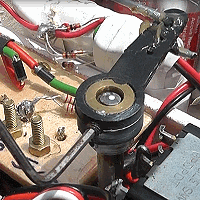 Friday 6th June: Yes, the loose rudder lever gradually got worse, due to the grub screw having moved several turns: in fact,
it was in danger of falling out ! Armed with the right tool - the Allen Key - the rudder was centred and the grub screw tightened
up. It was then launched from Snoopy Corner, where the repair was done, a bit before the 1:05 SPOT Position Report.
Snoopy had drifted to the north bank of Snoopy Corner by 10pm last night, then drifted away by 1am, then a long way east,
along the lake, to the bank near the island by 4am. Winds had been light all night, in the region of 2mph or more, so
it was known this could have been the cause. Snoopy could not be reached with the pole, so I paid for a "rescue"
- but just to have him moved out into the breeze, now blowing back to the western end of the lake. He took an hour to
drift to near the footbridge, because he was doing tight circles: half the time clockwise, then counter-clockwise. i.e.
the rudder was loose, and not always on the same side. I had a panini from the clubhouse while watching and filming things.
I had to pay for another rescue, because I could not reach where he landed, and they handed him over to me in Snoopy Corner.
That's where I saw the rudder had, by now, jammed 180 degrees from centre, and the cause was the loose grub screw.
The 5v batteries were good and high, fully charged (5.5v,5.53v->5.32v).
We will see if the grub screw comes loose again, while
we decide the best longer term solution, such as Locktight, Superglue, or resin.
Friday 6th June: Yes, the loose rudder lever gradually got worse, due to the grub screw having moved several turns: in fact,
it was in danger of falling out ! Armed with the right tool - the Allen Key - the rudder was centred and the grub screw tightened
up. It was then launched from Snoopy Corner, where the repair was done, a bit before the 1:05 SPOT Position Report.
Snoopy had drifted to the north bank of Snoopy Corner by 10pm last night, then drifted away by 1am, then a long way east,
along the lake, to the bank near the island by 4am. Winds had been light all night, in the region of 2mph or more, so
it was known this could have been the cause. Snoopy could not be reached with the pole, so I paid for a "rescue"
- but just to have him moved out into the breeze, now blowing back to the western end of the lake. He took an hour to
drift to near the footbridge, because he was doing tight circles: half the time clockwise, then counter-clockwise. i.e.
the rudder was loose, and not always on the same side. I had a panini from the clubhouse while watching and filming things.
I had to pay for another rescue, because I could not reach where he landed, and they handed him over to me in Snoopy Corner.
That's where I saw the rudder had, by now, jammed 180 degrees from centre, and the cause was the loose grub screw.
The 5v batteries were good and high, fully charged (5.5v,5.53v->5.32v).
We will see if the grub screw comes loose again, while
we decide the best longer term solution, such as Locktight, Superglue, or resin.
 Saturday 7th June: Snoopy still on 24/7 station: has now completed three weeks, and major faults found and fixed. Thunderstorms today, but also some
glimpses of the sun :-) I visited my local model shop, Mantua Models, and got some useful advice on how to stop the grub screw
coming out. The important thing is that I should still be able to unscrew it, with the Allen key, if I need to. e.g. to double-check
that I HAD remembered to file a flat on the shaft. I invested £5 in buying some "Loctite Blue" as it's known in the trade,
and another rudder lever.
It seems
grub screws coming out is a common problem with model cars, that have a lot more vibration. I've put some of this Loctite
onto the new lever, will wait for it to dry well, then see if I can get the grub screw out again :-)
Saturday 7th June: Snoopy still on 24/7 station: has now completed three weeks, and major faults found and fixed. Thunderstorms today, but also some
glimpses of the sun :-) I visited my local model shop, Mantua Models, and got some useful advice on how to stop the grub screw
coming out. The important thing is that I should still be able to unscrew it, with the Allen key, if I need to. e.g. to double-check
that I HAD remembered to file a flat on the shaft. I invested £5 in buying some "Loctite Blue" as it's known in the trade,
and another rudder lever.
It seems
grub screws coming out is a common problem with model cars, that have a lot more vibration. I've put some of this Loctite
onto the new lever, will wait for it to dry well, then see if I can get the grub screw out again :-)
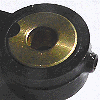 Sunday 8th June: I left the Loctite to dry and set 24 hours, before inspecting it closely: there is a nice solid fillet
around the grub screw (see left). Then the important test: can we still turn the grub screw if we need to ? The answer is "yes"
- no problem. I've put on some more Loctite blue to dry, before seeing the effect of water on it ! Meanwhile,
over at Bray Lake, Snoopy has held his 24/7 position well, with the occasional wander when the wind drops to less
than 3mph. Nice and sunny again today - hopefully he can continue the 24/7 test without batteries or something else failing ! :-)
When Snoopy is next brought home, to check things like water ingress (by weighing him), and repair any cracks,etc, we must remember
to Loctite his grub screw. The plan is to remove the lever, confirm there IS a flat filed on the rudder drive shaft (and make
one if there is not), then tighten the grub screw, and use Loctite around the screw and the top of the lever, including
the shaft.
Sunday 8th June: I left the Loctite to dry and set 24 hours, before inspecting it closely: there is a nice solid fillet
around the grub screw (see left). Then the important test: can we still turn the grub screw if we need to ? The answer is "yes"
- no problem. I've put on some more Loctite blue to dry, before seeing the effect of water on it ! Meanwhile,
over at Bray Lake, Snoopy has held his 24/7 position well, with the occasional wander when the wind drops to less
than 3mph. Nice and sunny again today - hopefully he can continue the 24/7 test without batteries or something else failing ! :-)
When Snoopy is next brought home, to check things like water ingress (by weighing him), and repair any cracks,etc, we must remember
to Loctite his grub screw. The plan is to remove the lever, confirm there IS a flat filed on the rudder drive shaft (and make
one if there is not), then tighten the grub screw, and use Loctite around the screw and the top of the lever, including
the shaft.
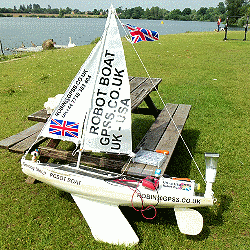 Monday 9th June: Snoopy drifted in to the west bank before 9am, due to the wind dropping off to practically zero.
We know this because the Bray Lake clubhouse guy said that, before 9am, the lake "was like a mirror", with no wind,
before it picked up again to more than 6mph - shown on the (occasionally inaccurate) Met Office site.
Snoopy had kept close to his position all night, with a small wander at 11pm when the wind may have dropped below 3mph.
At 8am the SPOT map showed him near his 24/7 position, so imagine my surprise, when visiting Bray Lake at 930am, with my
father-in-law (now 95), for a relaxed drink and chat - we saw Snoopy in the reeds, at the far end of the lake !
Monday 9th June: Snoopy drifted in to the west bank before 9am, due to the wind dropping off to practically zero.
We know this because the Bray Lake clubhouse guy said that, before 9am, the lake "was like a mirror", with no wind,
before it picked up again to more than 6mph - shown on the (occasionally inaccurate) Met Office site.
Snoopy had kept close to his position all night, with a small wander at 11pm when the wind may have dropped below 3mph.
At 8am the SPOT map showed him near his 24/7 position, so imagine my surprise, when visiting Bray Lake at 930am, with my
father-in-law (now 95), for a relaxed drink and chat - we saw Snoopy in the reeds, at the far end of the lake !
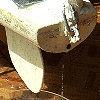 I paid the usual £5 for a rescue, and checked him out before Snoopy was brought home, for a thorough checkout.
At 0950, near the Clubhouse, Snoopy's autopilot was seen to be perfect, with the rudder still central, moving as it should,
and the main 5v power nice and high (5.41v,5.41v->5.17v). There was an egg cup full of water in the bottom of the box,
that might have crept up through the rudder post during those firce winds gusting up to 30mph some days ago.
Earlier in the morning our spare lever with dry loctite was imersed in water for test.
I also called in to Mantua Models and got some more good advice: there is a heat sensitive version "Loctite Pink",
that would need a soldering iron to undo the screw: none in stock, but we will stick to "Loctite Blue" for now - if needed at all.
Checks at home confirmed that grub screw was still tight, and the lever could not be moved. There was a small flat on the shaft,
but this was filed a bit more, and the top of the shaft scratched to take Loctight. It was then re-assembled, tightened up central
again, and Loctite blue applied on the grub screw (before adding) and the top of the post, including into the flat.
I paid the usual £5 for a rescue, and checked him out before Snoopy was brought home, for a thorough checkout.
At 0950, near the Clubhouse, Snoopy's autopilot was seen to be perfect, with the rudder still central, moving as it should,
and the main 5v power nice and high (5.41v,5.41v->5.17v). There was an egg cup full of water in the bottom of the box,
that might have crept up through the rudder post during those firce winds gusting up to 30mph some days ago.
Earlier in the morning our spare lever with dry loctite was imersed in water for test.
I also called in to Mantua Models and got some more good advice: there is a heat sensitive version "Loctite Pink",
that would need a soldering iron to undo the screw: none in stock, but we will stick to "Loctite Blue" for now - if needed at all.
Checks at home confirmed that grub screw was still tight, and the lever could not be moved. There was a small flat on the shaft,
but this was filed a bit more, and the top of the shaft scratched to take Loctight. It was then re-assembled, tightened up central
again, and Loctite blue applied on the grub screw (before adding) and the top of the post, including into the flat.
 The boat was weighed (without test equipment, of course) and was 15.05 kg. This seemed a lot, after the 14.25 kg WITH test equipent
on 10th May - but remember that repair to the keel on 29th May ! A 1/4"(6mm) hole was drilled at the back, at the bottom,
and the boat tilted about 30 degrees on it's stand, to let water drain out. A rod was pushed through the foam to encourage
the escape of water. Another 0.15L came out, added to what was drained from inside the box, adds up to about 0.2L (0.2Kg).
So we are still on target to be less than 15kg. The boat was laid on it's side and Trilux paint applied inside and over
a crack that had appeared where the deck meets hull. Silicon Sealant was added later. Remember the hull is full of foam - where there are not cavities.
I then squirted a LOT of foam into the 1/4" hole at the back, and could hear it forcing it's way into cavities,
and a little more water came out.
The boat was weighed (without test equipment, of course) and was 15.05 kg. This seemed a lot, after the 14.25 kg WITH test equipent
on 10th May - but remember that repair to the keel on 29th May ! A 1/4"(6mm) hole was drilled at the back, at the bottom,
and the boat tilted about 30 degrees on it's stand, to let water drain out. A rod was pushed through the foam to encourage
the escape of water. Another 0.15L came out, added to what was drained from inside the box, adds up to about 0.2L (0.2Kg).
So we are still on target to be less than 15kg. The boat was laid on it's side and Trilux paint applied inside and over
a crack that had appeared where the deck meets hull. Silicon Sealant was added later. Remember the hull is full of foam - where there are not cavities.
I then squirted a LOT of foam into the 1/4" hole at the back, and could hear it forcing it's way into cavities,
and a little more water came out.
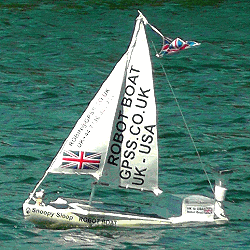 Much of the foam seeped back out, as is normal, both out of the hole I made - but also
near the rudder post tube. i.e. another leak fixed !
The 1/4" hole was then be filled with Isopon before painting. A new "UK to USA" label was stuck to the left side of the box,
because water had seeped into the lamination. It was stuck on with double sided carpet tape, then edges smeared with silicon sealant.
The nice surprise was that the boat now weighs just 14.5 kg !
Snoopy looks ready to put back on 24/7 duty ! :-)
Much of the foam seeped back out, as is normal, both out of the hole I made - but also
near the rudder post tube. i.e. another leak fixed !
The 1/4" hole was then be filled with Isopon before painting. A new "UK to USA" label was stuck to the left side of the box,
because water had seeped into the lamination. It was stuck on with double sided carpet tape, then edges smeared with silicon sealant.
The nice surprise was that the boat now weighs just 14.5 kg !
Snoopy looks ready to put back on 24/7 duty ! :-)
 The only disadvantage,
if friction remains, is slightly increased power consumption: the advantage is more effective sealing from water ingess !
Our first three weeks of 24/7 test of boat 10 revealed important faults like broken keel and the rudder servo linkage.
We will see what the coming days and weeks bring :-)
The only disadvantage,
if friction remains, is slightly increased power consumption: the advantage is more effective sealing from water ingess !
Our first three weeks of 24/7 test of boat 10 revealed important faults like broken keel and the rudder servo linkage.
We will see what the coming days and weeks bring :-)
Wednesday 11th June: Snoopy still near 24/7 position, in wind between 3 and 15mph. Loctite Blue was still stiff after two day water test here, so OK.
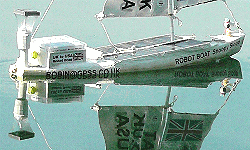 Thursday 12th June: Snoopy wandered when wind dropped below 1 or 2mph. At bank near Segway cabin by 6am (GPS scatter made
it look like he was on dry land!). Checked at 9am - covered in dew. 5v power good
(5.07,5.06->4.81v) but now weighs 15.25Kg - but no water inside box. Pushed out in "mirror" conditions,
without switching off autopilot. Only 5 or 10 yards
from bank at 10am, but thermals begining, so may get lucky, and make his way out to 24/7 waypoint. He did get lucky, with those thermals - got there by 11am :-)
Thursday 12th June: Snoopy wandered when wind dropped below 1 or 2mph. At bank near Segway cabin by 6am (GPS scatter made
it look like he was on dry land!). Checked at 9am - covered in dew. 5v power good
(5.07,5.06->4.81v) but now weighs 15.25Kg - but no water inside box. Pushed out in "mirror" conditions,
without switching off autopilot. Only 5 or 10 yards
from bank at 10am, but thermals begining, so may get lucky, and make his way out to 24/7 waypoint. He did get lucky, with those thermals - got there by 11am :-)
Friday 13th June: holding 24/7 position well, because wind rarely dropped below 3mph. Nice and sunny again today.
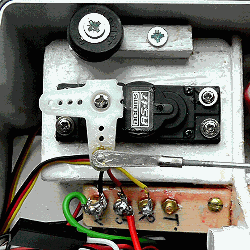 Saturday 14th June: Snoopy brought home, after a rescue, to find then fix a fault with the autopilot. It was a failed rudder servo*.
* Note added on 16th: post mortem showed 20k across power pins and o/c on a new servo. No water seen inside. Electronics failure ? e.g. capacitor ?
The boat is practically ready, to be put back on 24/7 test later today, and more detail is below.
Symptoms were that the rudder did not move when the autopilot was switched on. The main 5v power was good (5.07,5.05->4.8v)
and no water in the box. Weight still 15.25kg, so not taking on more water.
At home, the problem was quickly diagnosed as being the servo - by plugging in a new one,
into the Futaba socket in low left corner here. At first I thought the problem was the plug/socket,
since I had neglected to snip then solder the servo wires onto the terminals. The socket is only intended
for just such a test as this.
Saturday 14th June: Snoopy brought home, after a rescue, to find then fix a fault with the autopilot. It was a failed rudder servo*.
* Note added on 16th: post mortem showed 20k across power pins and o/c on a new servo. No water seen inside. Electronics failure ? e.g. capacitor ?
The boat is practically ready, to be put back on 24/7 test later today, and more detail is below.
Symptoms were that the rudder did not move when the autopilot was switched on. The main 5v power was good (5.07,5.05->4.8v)
and no water in the box. Weight still 15.25kg, so not taking on more water.
At home, the problem was quickly diagnosed as being the servo - by plugging in a new one,
into the Futaba socket in low left corner here. At first I thought the problem was the plug/socket,
since I had neglected to snip then solder the servo wires onto the terminals. The socket is only intended
for just such a test as this.
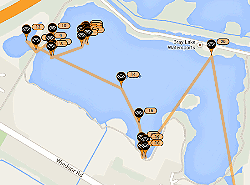 Simple tests, such as changing the plug, proved the socket was not the reason,
but out came my soldering iron !
The new Acoms AS-17 servo was prepared as usual: tightening the case screws,
smearing top with grease, and the rest with silicon sealant.
This particular servo has survived over 9 months (since 6th September 2013 - see
Blog1
)
including over a month of near continuous use.
and is the second time an AS-17 product, chosen years ago, has failed - unless water got inside.
It is possible that stiffness in the rudder movement (after squirting in that foam), contributed to the servo failing.
I could feel stiffness when the rudder was moved full left.
I used the opportunity to take out the rudder shaft, clean it, grease it, then reassemble - using Loctite Blue on the lever.
The rudder now moves nice and freely.
Last night, the
Spot Map
had shown Snoopy in the south east corner, from where he was later rescued,
by 4am. Before that, Snoopy had made an amazing trip, starting by drifting west at 8pm Friday,
when the wind fell to 3mph (much less near the trees), until he went under the footbridge,
to explore the adjacent wildlife lake at midnight ! The thunderstorm reached here about midnight, hours after he started wandering.
Amazingly, he found his way back out again, through the narrow channel, under the footbridge,
before drifting east across the lake.
Simple tests, such as changing the plug, proved the socket was not the reason,
but out came my soldering iron !
The new Acoms AS-17 servo was prepared as usual: tightening the case screws,
smearing top with grease, and the rest with silicon sealant.
This particular servo has survived over 9 months (since 6th September 2013 - see
Blog1
)
including over a month of near continuous use.
and is the second time an AS-17 product, chosen years ago, has failed - unless water got inside.
It is possible that stiffness in the rudder movement (after squirting in that foam), contributed to the servo failing.
I could feel stiffness when the rudder was moved full left.
I used the opportunity to take out the rudder shaft, clean it, grease it, then reassemble - using Loctite Blue on the lever.
The rudder now moves nice and freely.
Last night, the
Spot Map
had shown Snoopy in the south east corner, from where he was later rescued,
by 4am. Before that, Snoopy had made an amazing trip, starting by drifting west at 8pm Friday,
when the wind fell to 3mph (much less near the trees), until he went under the footbridge,
to explore the adjacent wildlife lake at midnight ! The thunderstorm reached here about midnight, hours after he started wandering.
Amazingly, he found his way back out again, through the narrow channel, under the footbridge,
before drifting east across the lake.
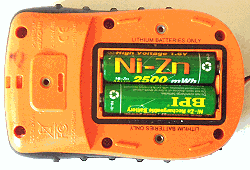 1430 update:
I just noticed that, for the first time in many weeks, the SPOT transmissions are slowing down, from the usual hourly reports,
to every 1.25 hours. This started this morning, and is a symptom of the SPOT 3.6v supply running low - and I can confirm - it is now 3.09v.
This may keep the boat at home a few more hours, while I investigate further.... diagnosed to one of the two Ni-Zn cells,
inside the SPOT, having failed - about 0.5v instead of the normal 1.8v. So, after visiting our Sunninghill Fete,
it's a trip to Maplins, to buy a pack of new Ni-Zn cells.
1430 update:
I just noticed that, for the first time in many weeks, the SPOT transmissions are slowing down, from the usual hourly reports,
to every 1.25 hours. This started this morning, and is a symptom of the SPOT 3.6v supply running low - and I can confirm - it is now 3.09v.
This may keep the boat at home a few more hours, while I investigate further.... diagnosed to one of the two Ni-Zn cells,
inside the SPOT, having failed - about 0.5v instead of the normal 1.8v. So, after visiting our Sunninghill Fete,
it's a trip to Maplins, to buy a pack of new Ni-Zn cells.
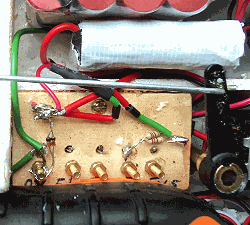 1900 update:
The relaunch back onto 24/7 test will have to wait until tomorrow. I realised earlier that the Ni-Zn cell probably failed due
to overcharging, due to the 3.6v zenars which clamp voltage from the 3xNiMH cells, and 6v 250mA solar panel, had probably all blown.
I realised this when, fast charging the 3.6v NiMH pack, I saw the voltage above 4v. Then I realised: those little 3.6v zenars
could handle the solar panel 250mA, but not fast charging at 2A ! I forgot the zenars when I fast charged :-( So, after our
trips to the village fete, Maplins, and then Eton Gardens (NGS Open day), there was just time to visit Maplins to buy more diodes.
Yes, that does say "LITHIUM BATTERIES ONLY" on the SPOT Messenger case - if you can read the small print :-)
1900 update:
The relaunch back onto 24/7 test will have to wait until tomorrow. I realised earlier that the Ni-Zn cell probably failed due
to overcharging, due to the 3.6v zenars which clamp voltage from the 3xNiMH cells, and 6v 250mA solar panel, had probably all blown.
I realised this when, fast charging the 3.6v NiMH pack, I saw the voltage above 4v. Then I realised: those little 3.6v zenars
could handle the solar panel 250mA, but not fast charging at 2A ! I forgot the zenars when I fast charged :-( So, after our
trips to the village fete, Maplins, and then Eton Gardens (NGS Open day), there was just time to visit Maplins to buy more diodes.
Yes, that does say "LITHIUM BATTERIES ONLY" on the SPOT Messenger case - if you can read the small print :-)
 Sunday 15th June: Snoopy was relaunched at 4pm today, on Bray Lake 24/7 reliability test, after a few hours running
in the garden - to test the new rudder servo and repairs to the SPOT power system. Two new Ni-Zn cells were put
in the SPOT Messenger, after charging in the special charger needed. A new pack of three Maplin Ni-MH cells were soldered up
and charged. Two new 3.6v Zenar diodes (in parallel) were added, to replace the damaged ones - yes, there were signs of them
having burnt out ! The first automatic report was at 1127 and we can expect these every hour, gaining a minute, every day or two.
That fast charging at 2A might also have damaged the Ni-Zn cell(s).
My lesson was that I should have remembered to follow the correct procedure for re-charging the SPOT subsystem:
Sunday 15th June: Snoopy was relaunched at 4pm today, on Bray Lake 24/7 reliability test, after a few hours running
in the garden - to test the new rudder servo and repairs to the SPOT power system. Two new Ni-Zn cells were put
in the SPOT Messenger, after charging in the special charger needed. A new pack of three Maplin Ni-MH cells were soldered up
and charged. Two new 3.6v Zenar diodes (in parallel) were added, to replace the damaged ones - yes, there were signs of them
having burnt out ! The first automatic report was at 1127 and we can expect these every hour, gaining a minute, every day or two.
That fast charging at 2A might also have damaged the Ni-Zn cell(s).
My lesson was that I should have remembered to follow the correct procedure for re-charging the SPOT subsystem:
1. Remove the Ni-Zn cells from the SPOT and charge them in their correct Ni-Zn charger.
2. Unsolder the zenar diodes protecting the 3.6v supply from over-charging.
3. Charge the three Ni-MH cells. OK to fast-charge these.
4. Check SPOT NiZn and Ni-MH packs are at similar voltage, near 3.6v. e.g. 3.64v. If not, charge/discharge Ni-MH to match.
5. Re-Solder the Zenar diodes, then plug in the SPOT Messenger with triplicated Futaba connectors.
First transmission should be an hour later, then every hour.
I've reset the
Spot Map
and we can watch how well Snoopy keeps to his 24/7 position. Dull today: should get brighter; wind not expected to drop for a few days.
June complained about dirt from the boat getting on my jacket. This old plastic apron should help.
Nice match to the hat with dreadlocks.
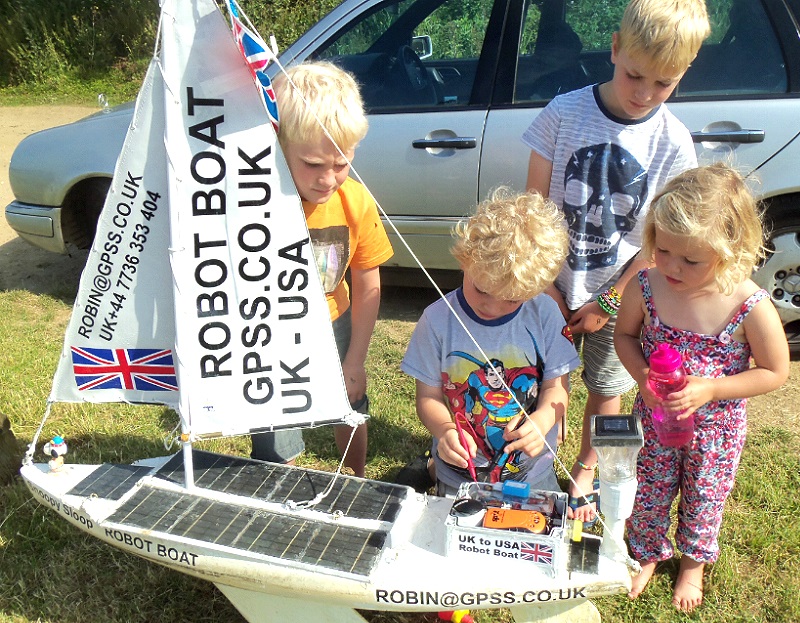 Monday 16th June: Snoopy keeping close to 24/7 position, with a slight wander after 1am (due to wind dropping ?). Bright today.
Monday 16th June: Snoopy keeping close to 24/7 position, with a slight wander after 1am (due to wind dropping ?). Bright today.
Tuesday 17th June: Snoopy still close to his 24/7 position, with wind above 5mph all night. Sunny today.
Wednesday 18th June: Snoopy still OK as above. SPOT timer lost 1 min/3 days, not gained (now 28 past). Useful guide to SPOT power ?
Thursday 19th June: Snoopy wandered after wind dropped after 828pm. Hit north bank by 0728am but out by 0928.
Sunny and breezy now.
Friday 20th June: Snoopy pushed out at midday, after drifting there in wind 1 or 2 mph. Now sunny and 3mph+.
Monday 23rd June: 8 days OK, without failure. Pushed with pole away from west bank in mirror conditions after 11am. Sun but no wind.
Tuesday 24th & Wednesday 25th June: 10 days OK. Slight wander 9pm until midnight on 23rd, when wind fell,
but held 24/7 station all night. Bright again today (both days).
Thursday 26th then Friday 27th June: 12 days OK. Bright, cloudy & rain showers.
While we wait for a launch window, I "work" on electronics for next year's boat. e.g. a
Compass.
Sunday 29th June: 14 days sailing OK without failure. Cloudy but bright. Watching
Magic Seaweed for launch window. Not for two weeks yet ?
Monday 14th July: 29 days (over 4 weeks) OK, continuous sailing without failure: Sunny, some rain, winds to 30mph.
700 miles ? Snoopy comes home for a cleanup.
 Wednesday 16th July: Snoopy home on 15th, for a clean, inspection, and paint: soapy water, dry, then two coats of Trilux 33.
Thimble full of water in box,
but all working perfectly: Battery voltages high (5v Main 5.38,5.42->5.23v and Spot 3.6 at 3.84v). Weight was 15.15 kg
but then 15.5 kg after paint dry.
Wednesday 16th July: Snoopy home on 15th, for a clean, inspection, and paint: soapy water, dry, then two coats of Trilux 33.
Thimble full of water in box,
but all working perfectly: Battery voltages high (5v Main 5.38,5.42->5.23v and Spot 3.6 at 3.84v). Weight was 15.15 kg
but then 15.5 kg after paint dry.
Thursday 17th July: 31 days (over 4 weeks) OK, continuous sailing - not including home for
Painting. Wandered to bank when no wind, but pushed out twice by Tim.
Tuesday 22nd July: 36 days OK, continuous sailing without failure. Push out after no wind.
Thanks for stand Eric : click on right Trolley picture to see better.
Tuesday 12th August: 57 days (over 8 weeks) without failure, waiting for launch window. SPOT good, losing just 45sec/day.
Snoopy's Trolley needs bigger wheels ! :-)

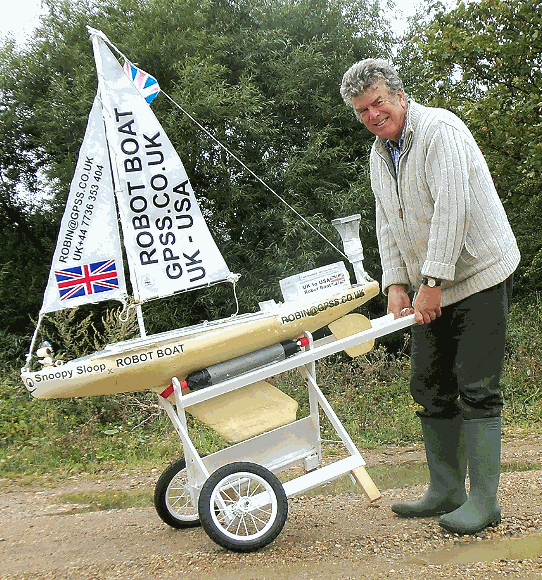 Thursday 14th August: Click on the SPOT map on the left, to see it more clearly: Snoopy sailed from 24/7 position at 10am to opposite South East corner, with 5 to 10 mph wind from South West
- according to the Met Office web site ! But by 2216 he was back near Base.
Thursday 14th August: Click on the SPOT map on the left, to see it more clearly: Snoopy sailed from 24/7 position at 10am to opposite South East corner, with 5 to 10 mph wind from South West
- according to the Met Office web site ! But by 2216 he was back near Base.
All the signs that he is still working, and the wind had dropped to nothing, despite the Met web site! Snoopy will be checked tomorrow, and will probably return to 24/7.
Friday 15th August: Snoopy was where we expected, near his Base. His autopilot was still running, operating the rudder,
and his box at the back was opened for inspection: not any trace of water, and main 5v supply was a bit low, but enough
(4.79,4.89->4.63v). Everything looked OK, other than the expected "slime" over the paintwork. He was soon put back in Snoopy Corner,
to go on "24/7 Duty" again. Enquiries in the clubhouse were not able to confirm that the wind dropped yesterday morning,
at about 9am, but there had been electrical storms. Alex mentioned that, at about 4pm, the girl's hair were "standing on end" :-)
Best guess is that the "wander" was due to the wind having dropped, but the next most likely explanation is that the solar power
had fallen to lower voltage levels, then picked up again: not likely, because of when it happened, and the direction Snoopy
wandered - but we will watch what happens in the coming days.
Robin used the opportunity to try Snoopy's trolley out, with it's bigger wheels. Click on the picture, to see the bigger version,
and on the smaller one above it, for the origin of the wheels - thanks Dick ! :-)
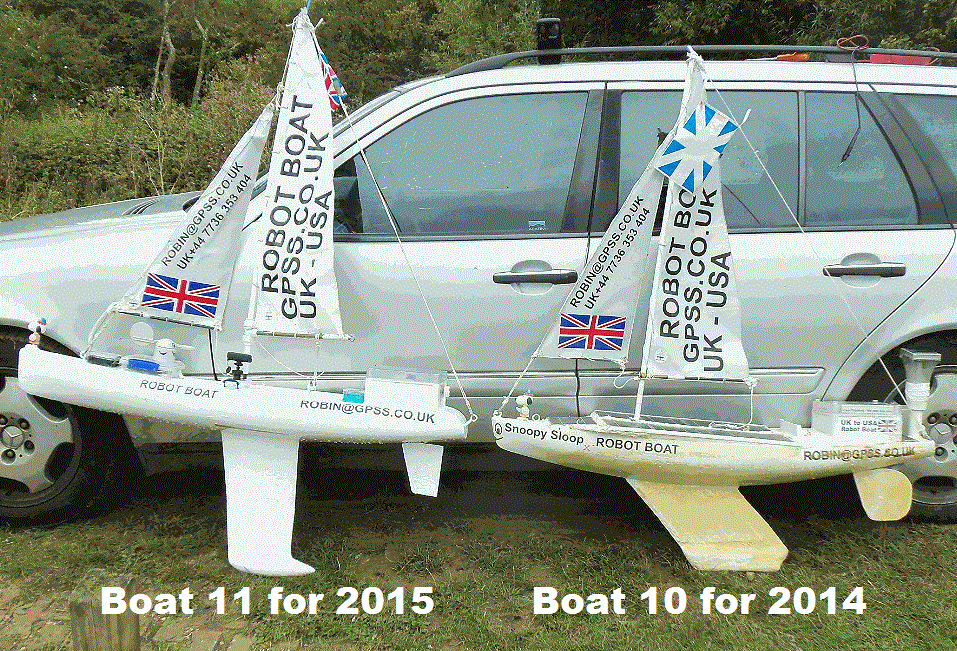 Wednesday 27th August: Snoopy home to recharge low batteries (no sun for days) and a clean.
Wednesday 27th August: Snoopy home to recharge low batteries (no sun for days) and a clean.
Thursday 28th August: Snoopy Sloop 10 was put back onto 24/7 duty at 0925 and the SPOT map reset, for clarity. Click on the
picture on the right, to see the bigger version, of boat 10 with the new boat 11, being prepared for next year's 2015 attempt.
Boat 11 had it's maiden sail earlier this week, and has already completed The Bray Lake Test four times. A few more months
will be needed, before this new boat is ready. The duplicated 5v batteries in boat 10 were very low, at about 3.5v, and were
fully charged last night ( 5.36,5.35->5.13v dropping to 5.9v after switching on for several minutes). Some of the scum was washed
off the hull, and the faded plastic flag, at the top of the mast, replaced by another. Boat 10 had taken on some more water,
into the hull, and now weighs 16.15 kg. Compare this with an almost identical new boat 11 which is nearer 10 kg ! Boat 10
(previously Boat 9) has had a lot of repairs, since it was built in 2013, but more care has been paid to weight in the new boat.
The draft of Boat 10 is 37cm/14.5" but that of Boat 11 is 46cm/18", requiring one to wade out further for launch or recovery.
Wednesday 3rd September: brought home to Sunninghill ready for possible launch. Power OK (4.82,4.96->4.69v) and weight 16.15 kg.

 24/7 reliability testing will then continue, while we wait for a suitable "launch window" for this year's next Atlantic attempt.
We need an off shore breeze and FLAT surf conditions. For this we watch
Magic Seaweed.
Play the
June 2014 video of Snoopy's Robot Boat for 2014 Microtransat
for relevant background.
Experiments with Boat6 in July: see
Recce,
Compass
and
Software pages.
Play the new
July 2014 video of Snoopy's Robot Boat Race to see how well
Snoopy's 2014 boat 10 did against the smaller experimental boat 6.
24/7 reliability testing will then continue, while we wait for a suitable "launch window" for this year's next Atlantic attempt.
We need an off shore breeze and FLAT surf conditions. For this we watch
Magic Seaweed.
Play the
June 2014 video of Snoopy's Robot Boat for 2014 Microtransat
for relevant background.
Experiments with Boat6 in July: see
Recce,
Compass
and
Software pages.
Play the new
July 2014 video of Snoopy's Robot Boat Race to see how well
Snoopy's 2014 boat 10 did against the smaller experimental boat 6.



Snoopy's Bray Lake Test ... sail 530 metres automatically, through 5 waypoints ...

This blog continues on the
Current Blog.